INTERVIEW
The Kingfield Approach
ESUSTAINABILITY
Unleashing Sustainability
DIGITAL TWIN
Digital Twins Are the Sharpest Tools in the Shed
AUGUST 2023 | CBNME.COM
REVOLUTIONIZING CONSTRUCTION TECHNOLOGIES:
THE FUTURE OF BUILDING IN THE MIDDLE EAST
 THE DEFINITIVE GUIDE TO THE REGION'S CONSTRUCTION PROFESSIONALS
THE DEFINITIVE GUIDE TO THE REGION'S CONSTRUCTION PROFESSIONALS





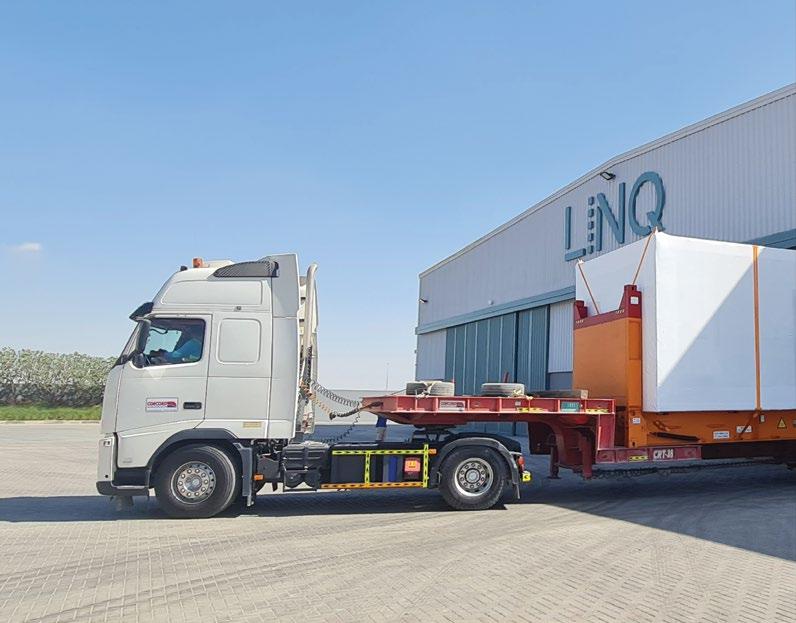



IN THIS ISSUE CBNME 10 58
ExperienceFAIRMONT MOMENTS


SUSTAINABLE FOREFRONT

EMBRACING CUTTING-EDGE CONSTRUCTION TECHNOLOGY IN THE MIDDLE EAST
technology used by contractors and consultants in large-scale projects across the Middle East. As the region rapidly evolves, innovative technologies are transforming the construction landscape, revolutionizing project delivery and sustainability.
Throughout these pages, you'll discover how the Middle East has embraced modular construction, digital construction, technological innovations, AI, Building Information Modeling (BIM), enabling streamlined collaboration and cost efficiency.
Our magazine invites you to explore how construction technology intertwines with cultural heritage and contemporary vision, shaping the Middle East's thriving construction landscape.
Delve into these captivating narratives of innovation, vision, and progress, where the Middle East shines as a beacon of excellence in construction technology. Happy reading!
its economy. Saudi Arabia, with its abundant renewable energy resources and ambitious goals, has embraced sustainable construction as a pivotal element of its development strategy. The implementation of eco-friendly building practices, such as energy-efficient designs, water conservation measures, and the use of sustainable materials, has gained significant traction. The Saudi government has introduced strict regulations and incentives to promote sustainable construction, including the establishment of green building certification systems. Collaborations with international organizations and the active involvement of local communities have fostered the exchange of knowledge and innovative sustainable construction practices. These initiatives have not only reduced environmental impact but also generated employment opportunities and enhanced the overall resilience and appeal of Saudi Arabia's built environment. In this edition we dive deep into this topic. KSA’s construction powerhouses give us valuable insights into initiatives and strategies implemented to make construction projects more sustainable.
CEO Wissam Younane wissam@bncpublishing.net
Wissam wissam@bncpublishing.net
DIRECTOR
DIRECTOR
Rabih Najm rabih@bncpublishing.net
Rabih rabih@bncpublishing.net
GROUP PUBLISHING DIRECTOR
Joaquim D'Costa jo@bncpublishing.net
PUBLISHING DIRECTOR D'Costa jo@bncpublishing.net +971 50 440 2706
+971 50 440 2706
MANAGING EDITOR Kasun Illankoon kasun@bncpublishing.net

Illankoon kasun@bncpublishing.net
Vibha
EDITOR Vibha Mehta vibha@bncpublishing.net
EDITORIAL DESIGN
Christian Harb
EDITORIAL DESIGN Harb
MARKETING MANAGER
MANAGER Joshua Sinanbam aj@bncpublishing.net
Aaron Joshua Sinanbam aj@bncpublishing.net
VIDEOGRAPHER
Alexander Bungas
SUBSCRIBE
ustainable construction projects have been on the rise in Saudi Arabia, reflecting the nation's dedication to environmental preservation and its vision for a sustainable future. The country recognizes the pressing need to decrease its carbon emissions and diversify

Welcome to this edition of our Construction Business News ME Magazine, where we dive into the dynamic world of construction
Kasun Illankoon Managing Editor kasun@bncpublishing.net
subscriptions@bncpublishing.net
Alexander Bungas Keep
For all commercial enquiries, contact jo@bncpublishing.net
For
T +971 50 440 2706
All rights reserved © 2022. Opinions expressed are solely those of the contributors.
Ssubscriptions@bncpublishing.net PO Dubai, United Arab Emirates P +971 4 4200 506 | F 4 4200 196 CBNME @CBNME CONSTRUCTION BUSINESS NEWS ME

Construction Business News ME and all subsidiary publications in the MENA region are officially licensed exclusively to BNC Publishing in the MENA region by Construction Business News ME

6 | CONSTRUCTION BUSINESS NEWS ME | AUGUST 2023 WWW.CBNME.COM EDITOR’S NOTE CBNME
up to date with all the latest news, features and much more on our website and social media platforms
CBNME.COM
News
copyrighted
not
Shutterstock. Printed by UPP PO Box 502511 Dubai, United Arab Emirates P +971 4 4200 506 | F +971 4 4200 196 CBNME @CBNME CONSTRUCTION BUSINESS NEWS ME
No part of this magazine may be reproduced or transmitted in any form or by any means without written permission of the publisher. Images used in Construction Business
ME are credited when necessary. Attributed use of
images with permission. All images
credited courtesy
6 | CONSTRUCTION BUSINESS NEWS ME | JULY 2023 WWW.CBNME.COM EDITOR’S NOTE
Keep up to date with all the latest news, and much more on our website and social media platforms CBNME.COM
Kasun Illankoon Managing Editor kasun@bncpublishing.net commercial enquiries, T 440 2706 All reserved © 2022. expressed are solely contributors. Business News and all subsidiary publications in MENA region are officially exclusively to BNC Publishing in the MENA region by Construction Business ME No part may be reproduced or in any form or by any means without written permission in Construction Business News credited when necessary. Attributed use of copyrighted images with permission. All images credited courtesy Shutterstock. Printed by UPP

Nestled by the coast of Lusail sits the splendor of Raffles and Fairmont Doha, where luxury is rooted in even the smallest details. Open the doors to mesmerizing hospitality and make memories in a world of sophistication.
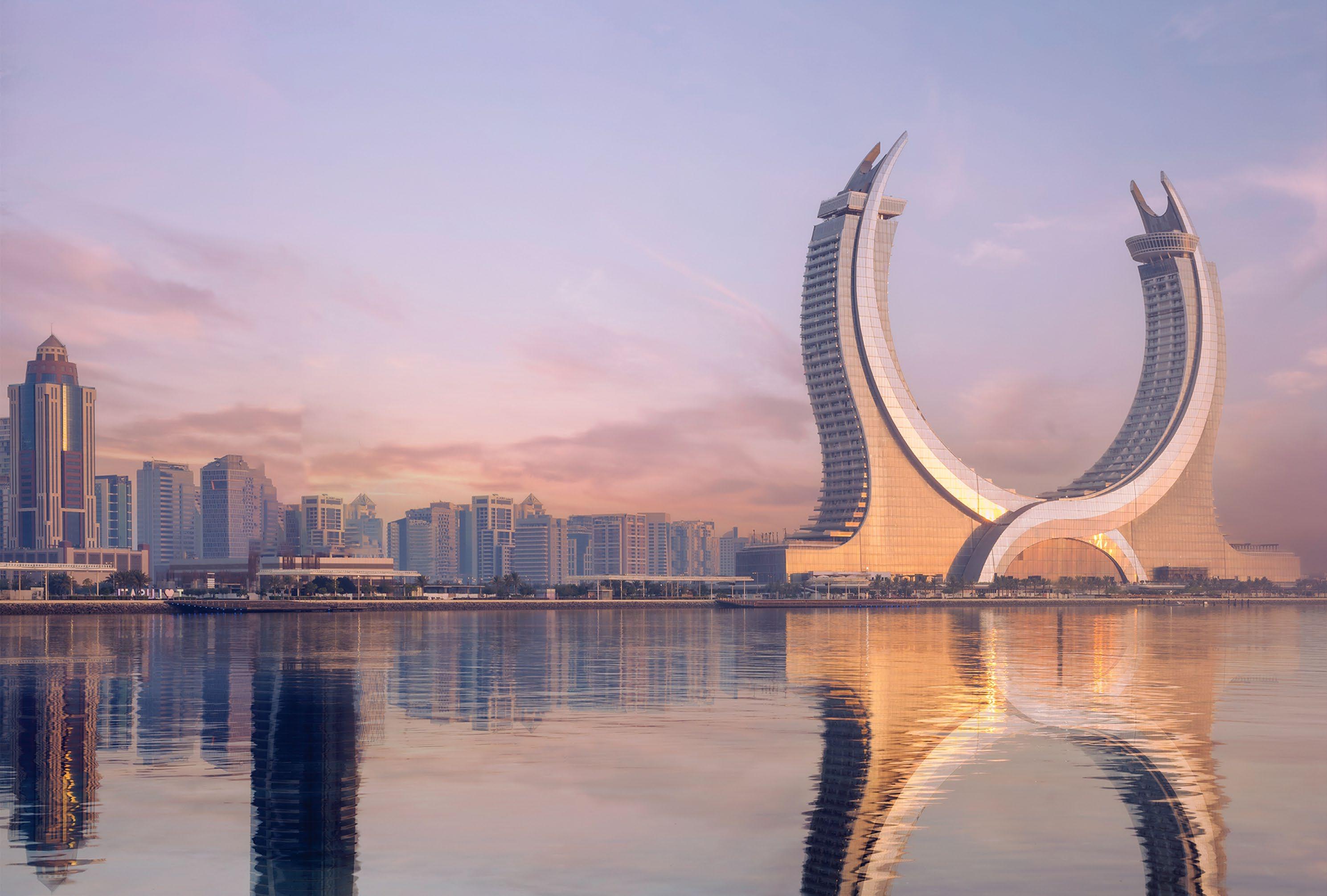

raffles.com/doha | fairmont.com/doha MEMBER OF - THE LIMITLESS LOYALTY PROGRAMME
Anilkumar Madhavan - Regional Director MEP (left) and Deepak Bashetty - Regional Director Structures at KPM Engineering
UnleashingSustainability
Anilkumar Madhavan, Regional Director MEP and Deepak Bashetty, Regional Director Structures – KPM Engineering, discuss developing sustainable practises in the region.

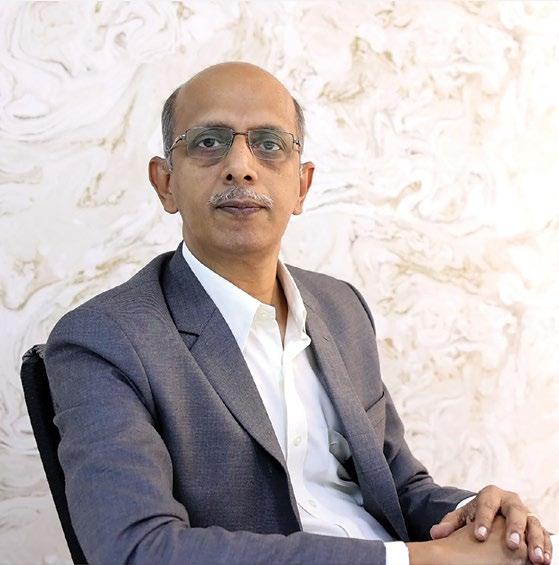
PROJECT: / Mixed-use development, Mecca /
This 4.5 million square foot multi-use complex in Mecca includes hotels, serviced apartments, and retail space. KPM Engineering (KPM) had various chances to apply a variety of sustainable engineering methods, including greywater recycling, condensate recovery, groundwater recharge, and overhang balconies, due to the project's magnitude.
Greywater recycling is an environmentally friendly practice that involves cleaning and reusing water from domestic appliances such as washing machines, showers and sinks. Although unfit for drinking, this water can be cleaned and used efficiently for irrigation, toilet flushing, and even industrial applications.
By implementing greywater recycling systems, KPM significantly reduced the strain on freshwater resources and decreased the demand for more energy-intensive water treatment and distribution. This approach not only conserved water but also saved energy by reducing the need for pumping and treating fresh water, making it an essential sustainable engineering strategy for water and energy conservation.
In air conditioning and refrigeration systems, condensate is formed when warm air comes into contact with a cold surface, resulting in moisture condensing. Instead of letting this water go to waste, KPM utilised condensate recovery systems in buildings to capture and collect condensate for reuse. By recycling this water for secondary uses, including landscape irrigation or non-potable water usage, we can effectively conserve water resources. Furthermore, as condensate recovery reduces the need for additional water supply, it also contributes to energy
10 | CONSTRUCTION BUSINESS NEWS ME | AUGUST 2023 WWW.CBNME.COM CBNME SUSTAINABILITY
UNLEASHING SUSTAINABILITY | ANILKUMAR MADHAVAN AND DEEPAK BASHETTY
conservation by reducing the energy required for water pumping and treatment processes.
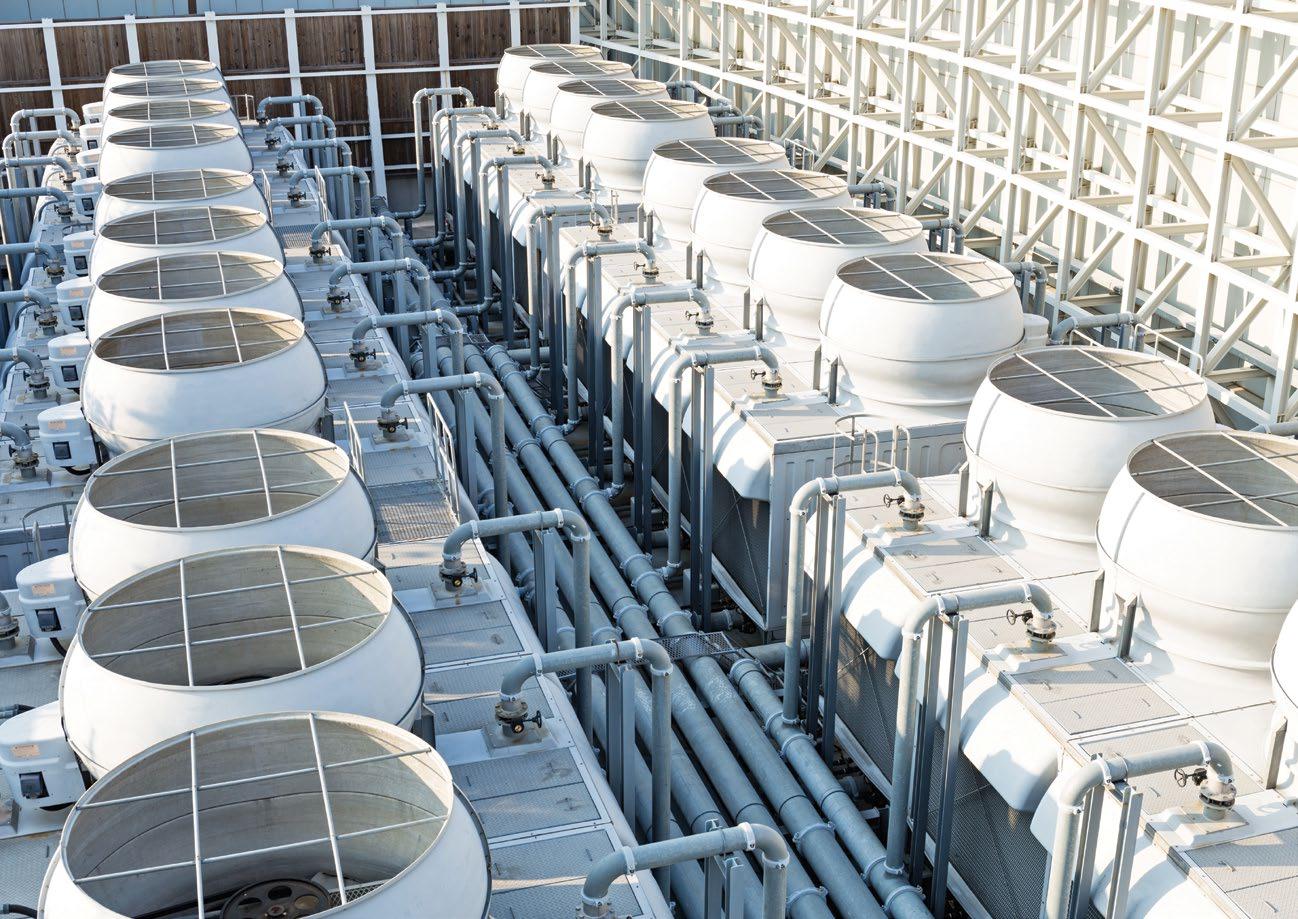
Groundwater recharge aims to replenish existing underground water sources. KPM designed the stormwater systems to capture and direct excess surface water, such as rainwater or stormwater runoff, into the ground to recharge aquifers. KPM effectively restored groundwater reserves by applying techniques such as rainwater collecting, permeable pavement, and infiltration basins. This method not only helps to keep the water table stable, but it also adds to energy saving. We can eliminate the need for energyintensive procedures, such as pumping water from deeper aquifers or remote sites, by replenishing groundwater sources, resulting in significant water and energy savings. >>>
To reduce incident solar radiation and subsequently decrease air conditioning loads, KPM suggested overhang balconies. By incorporating strategically designed overhangs on buildings, especially those with the most sun exposure, KPM created shading that prevented direct sunlight from entering living spaces during peak heat periods. This helped to reduce the cooling demand and reliance on air conditioning systems, thereby conserving energy. Overhang balconies not only provide passive cooling but also offer additional benefits, such as creating outdoor spaces that can be utilised for recreational purposes and promoting sustainable architecture that harmonises with environments.
In summary, implementing practices such as greywater recycling, condensate recovery, groundwater recharge, and overhang balconies can significantly contribute to water and energy conservation efforts. These approaches not only help preserve precious water resources but also reduce the demand for energy-intensive processes, including water treatment and pumping. Through the implementation of these sustainable strategies on project sites, KPM moves towards a more environmentally conscious future and ensures a better balance between water and energy needs.
By recycling, the water for secondary uses, including landscape, irrigation or non-potable water usage, we can effectively conserve water resources.
CBNME SUSTAINABILITY
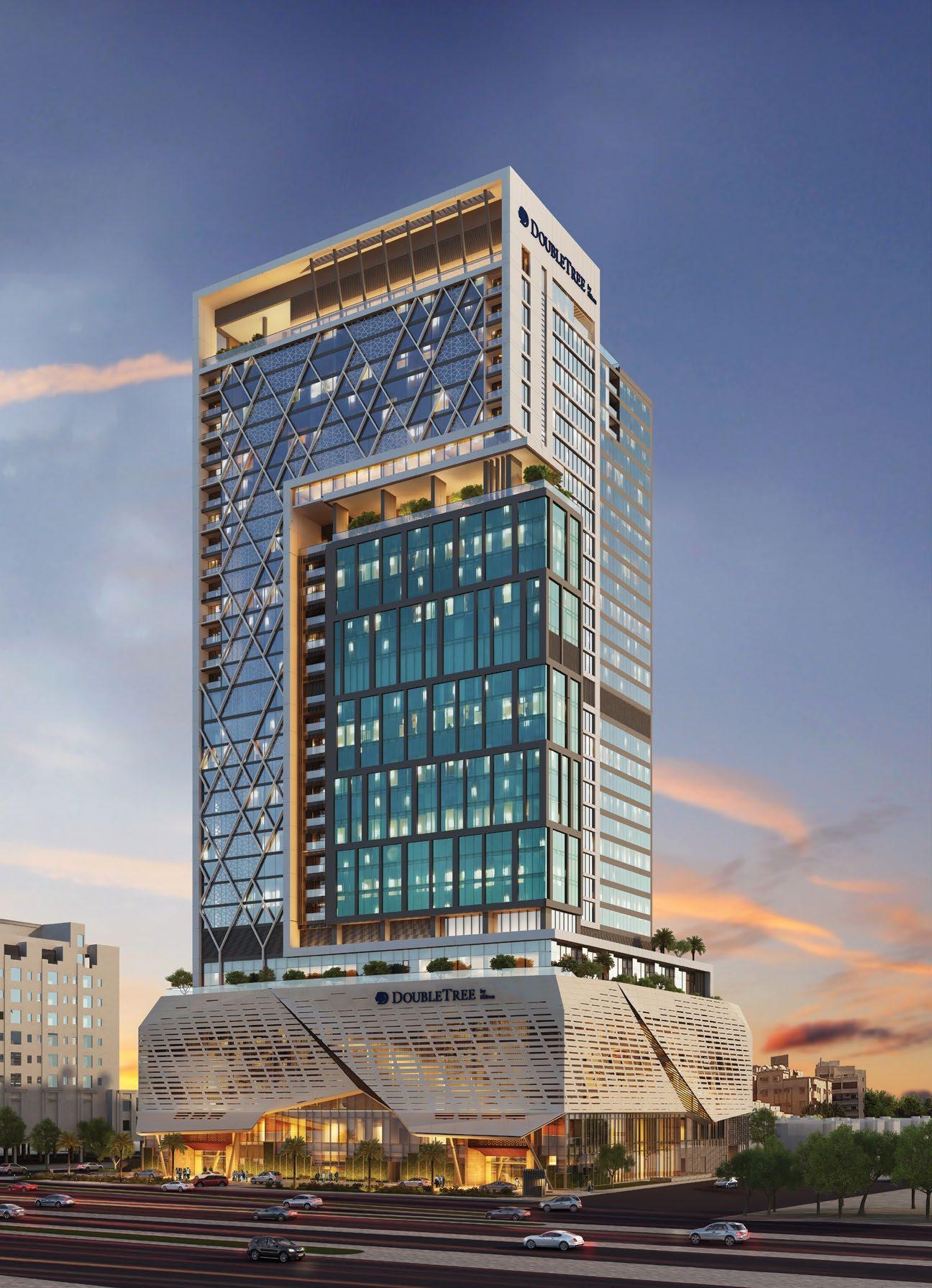
12 | CONSTRUCTION BUSINESS NEWS ME | AUGUST 2023 WWW.CBNME.COM
Double Tree, Jeddah: During this particular project, the generated construction waste was repurposed as backfill material on-site.
PROJECT / Ministry of Culture Parking, Jeddah /
The Ministry of Culture project was part of the initiative to upgrade the Allegiance Square area. The plan included the development of two levels of underground parking with access to the Corniche via underground pedestrian tunnels. Considering the location and the number of people expected to use the facility, the client wanted to explore options to make the parking area more suitable for pedestrian use. As the temperatures in summer in the region are high, one of the avenues KPM explored was to look at the possibility of cooling the area with minimum energy costs.
KPM proposed evaporative cooling as an effective and energy-efficient technique to significantly reduce temperatures without relying on traditional airconditioning systems. This method utilises the natural process of evaporation to cool the surrounding and is particularly suitable for dry and arid climates where humidity levels are low. The outcoming air is cooled down between 10 to 15 degrees Celsius, and unlike traditional air conditioning, evaporative cooling does not recirculate warm, polluted indoor air. Rather, it ventilates 100 per cent fresh, filtered, clean, and cooled air into a room or building. As a result, the indoor air quality substantially improves. We achieved considerable cooling benefits using approximately 10 per cent of the energy required for mechanical cooling.
Introducing skylights in underground parking areas is another innovative method to maximise natural lighting in what are typically dark and enclosed spaces. Underground parking structures rely heavily on artificial lighting, which not only consumes energy but also fails to provide the benefits of natural sunlight. By strategically placing skylights in the roof or walls of the parking structure, we allowed natural light to penetrate into spaces, creating a brighter and more inviting environment. This not only enhanced the visibility for drivers and pedestrians but also reduced the need for artificial lighting during daylight hours,
KPM proposed for Ministry of Culture Parking project, the evaporative cooling method as an effective and energyefficient technique to significantly reduce temperatures without relying on traditional air-conditioning systems.
The addition of natural light also improved the overall aesthetics and user experience, making the subterranean parking feel more open, safe, and comfortable to move through.
leading to significant energy savings across projects. The addition of natural light also improved the overall aesthetics and user experience, making the subterranean parking feel more open, safe, and comfortable to move through.
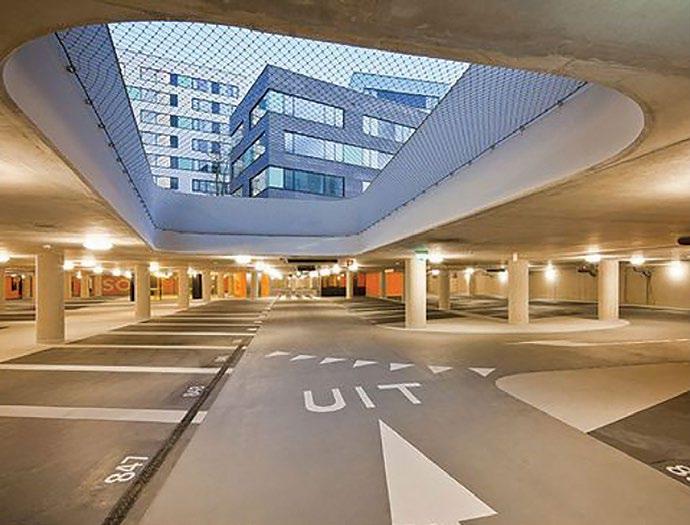
PROJECT:
/ Double Tree, Jeddah /
Commercial construction operations typically yield a solid waste output ranging from 2 to 2.5 pounds per square foot, a significant portion of which can be recycled. The process of salvaging and recycling construction and demolition (C&D) waste can have a substantial impact on diminishing the need for new resources and mitigating associated environmental consequences.
To achieve this, the implementation of a comprehensive construction waste management plan is crucial, which KPM designed and implemented. The primary objective is to minimise the volume of materials destined for landfills during the construction process by facilitating the reuse of construction waste. During this particular project, the generated construction waste was repurposed as backfill material on-site. Furthermore, concrete waste underwent crushing procedures to transform it into fill materials suitable for occupying void spaces within the structure.
It is possible to reduce contamination concerns and extend the operating lifespan of existing landfills by implementing effective construction waste management practices, including the proper handling of non-recyclable materials.
CONSTRUCTION BUSINESS NEWS ME | AUGUST 2023 | 13
UNLEASHING SUSTAINABILITY | ANILKUMAR MADHAVAN AND DEEPAK BASHETTY
Over 13 years we have designed more than 750 education projects worldwide. The team has specified over 12.5M items of FF&E and built spaces across the world, including the UK, Europe, UAE, Thailand, Malaysia, and China.
Design Holistic

David JUDGE

THE EXECUTIVE CREATIVE DIRECTOR OF SPACE ZERO, DISCUSSES THE HOLISTIC APPROACH USED TO DESIGN THE CAMPUS INTERIORS AT NORD ANGLIA SCHOOL IN ABU DHABI.
How does Nord Anglia International School Abu Dhabi’s holistic approach to designing campus interiors align with the organisation's character and values?
Designing with a holistic approach is the heart of what Space Zero does – we specialise in creating environments that bring out the space’s character. We begin with a strategy before even looking at the spaces. With Nord Anglia International School Abu Dhabi, we discussed the values of the school, including a personalised approach to learning, creative encouragement and wellbeing empowerment – and ensured that this was communicated throughout the spaces.

14 | CONSTRUCTION BUSINESS NEWS ME | AUGUST 2023 WWW.CBNME.COM CBNME INTERIOR DESIGN
Can you provide examples of how the interior design of the Nord Anglia International School Abu Dhabi campus reflects the school's teaching methods and philosophy?
The overall interiors reflect on the school’s teaching method with Nord Anglia International School Abu Dhabi’s request to apply the theme of advanced learning and exceptional environments around the whole campus. We examined how each individual space would work by not only meeting the basic functionality of the space, but also how they might evolve in the next 5 to 10 years. We defined the spaces through three layers – character, functional requirements and how it delivers their values. The space is a communicational experience and so we think about the emotional response that the people will feel when they enter the space and how the space works overtime. It was important we designed areas to reflect NAS Abu Dhabi’s core values of inspiring creativity and encouraging well-being, resilience and purpose.
In what ways does Nord Anglia International School Abu Dhabi’s holistic approach to campus interior design cater to the evolving needs and expectations of the future of education?
Nord Anglia International School Abu Dhabi holistic approach to its campus interior designs caters to the evolving needs and expectations of the future of
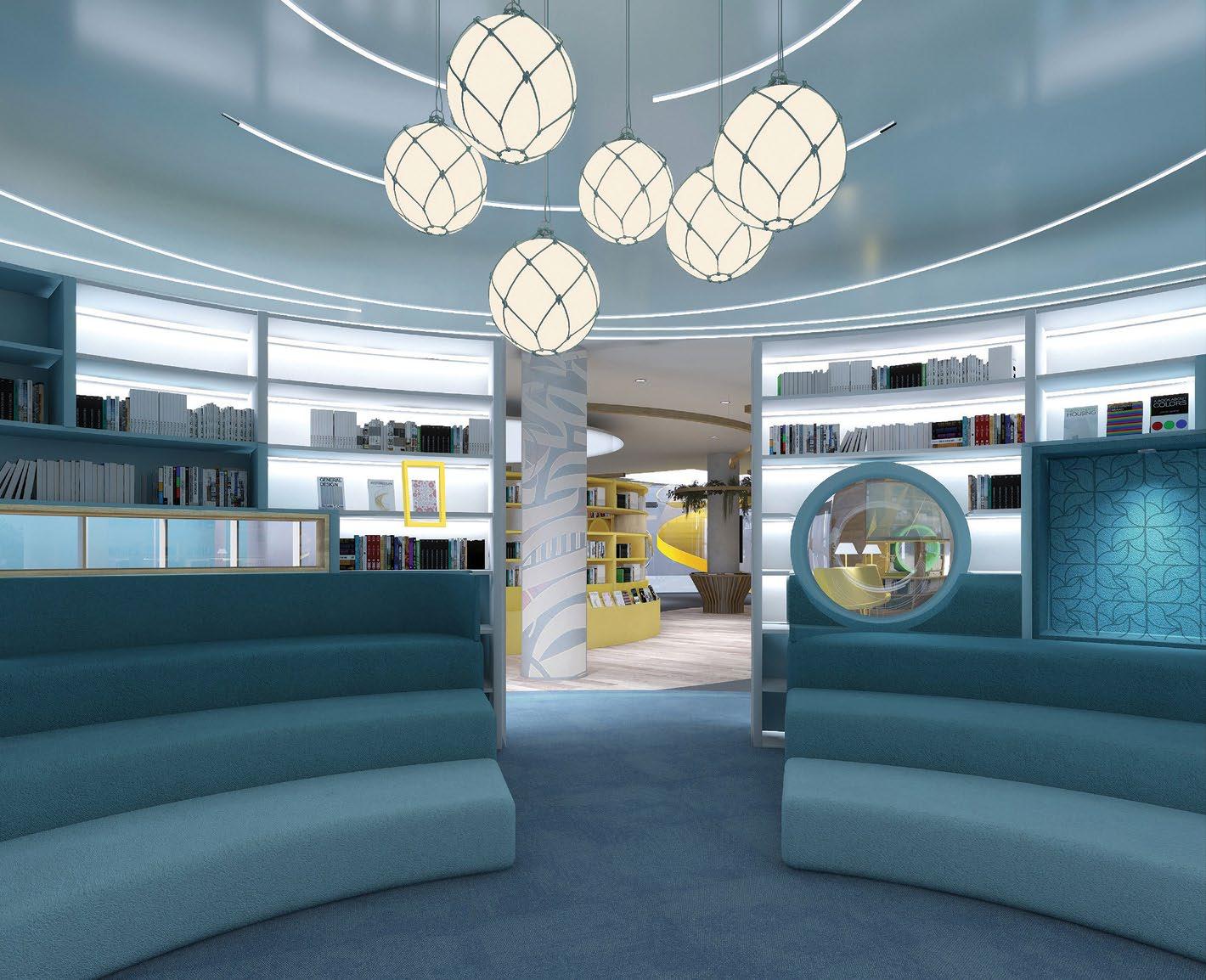
education in several ways. Their goal is to give a calm and warm feeling for the students to feel like they belong. For example, the technology aspect in the primary library will be very present with devices, however this will not affect the desire for the students to read a story and collaborate with each other in the specially designed areas of the library.
What key factors or considerations were taken into account when designing the Nord Anglia International School Abu Dhabi campus interiors to create an optimal learning environment for students and teachers? There are multiple key factors that were taken into account at Nord Anglia International School Abu Dhabi with the idea of future education and how the interiors create an optimal learning environment, as it’s not just one approach per space. For example, in the primary library we aimed to convey the idea of storytelling and so created different environments that tell different tales. The desert, aquatic, and forest locations were used to romanticise the idea of listening to words, what they signify, and how emotional responses are derived from this. It is also critical to consider children's ergonomics, so we developed a welcoming yet enjoyable environment that feels like home. We also created opportunities for cooperation in the same space, where students and teachers may work together and both feel like they belong. >>>
CONSTRUCTION BUSINESS NEWS ME | AUGUST 2023 | 15
The design team wanted to express the sense of storytelling in the primary library, therefore they built various locations that tell different stories.
CBNME INTERIOR DESIGN
How does the holistic approach to designing campus interiors at Nord Anglia International School Abu Dhabi contribute to fostering a sense of community and collaboration among students and faculty?
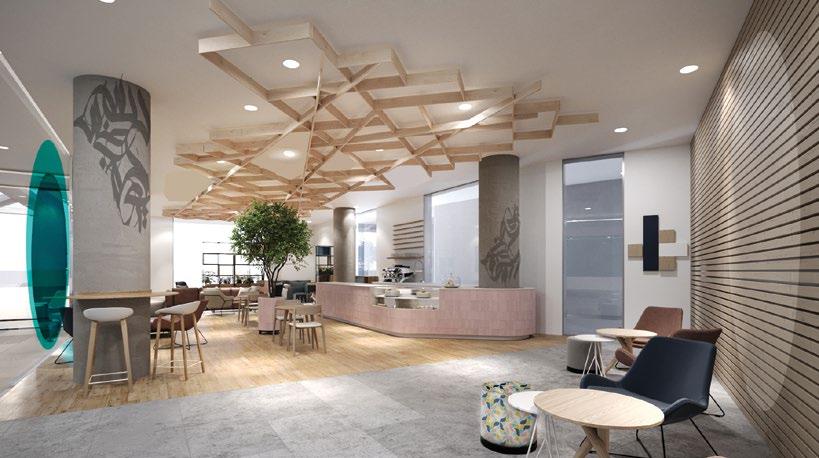
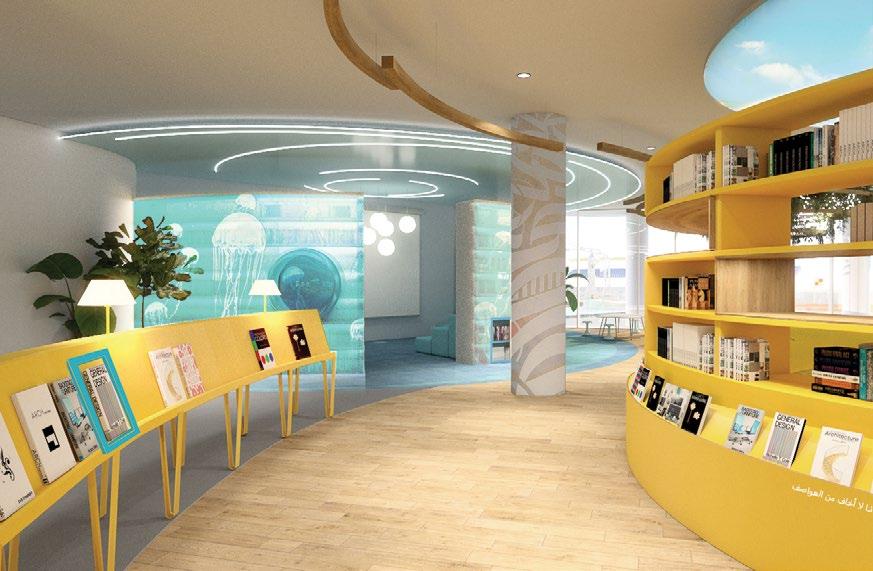
The holistic approach to designing campus interiors at Nord Anglia International School Abu Dhabi contributes significantly to fostering a sense of community and collaboration among students and faculty. There is a key academic principal that we refer to on the subject of belonging and the connection between the space and the person who owns this space. This means that we don’t design a space by thinking of it as just a facility – like many schools do. We believe that the idea of having it just as a functional space is a very old fashion approach. While functionality requirements are very important, we have to also consider how to give the people who are using the space a sense of belonging. We create an appropriate language for each group – considering language, communication, interior spaces, cultural integration and storytelling. We designed NAS Abu Dhabi with
the mindset that we want the students to feel safe with a sense of belonging. The more they enjoy the spaces, the more they want to stay and the better they will learn and collaborate together. A key area to highlight is the parents’ café. It’s a space where parents can get to know each other, as well
as the teachers – and it has been designed for them as a community to interact and collaborate.
Can you discuss any specific innovative design elements or features implemented in the Nord Anglia International School
Abu Dhabi campus interiors that enhance the overall learning experience and support the future of education?
The learning playground, positioned between the primary classrooms, is a highly particular innovative design element that will enrich the entire learning experience at Nord Anglia International School Abu Dhabi. We proposed using it as both a breakout room and a learning common with Nord Anglia International School Abu Dhabi. We addressed the ergonomics of young collaboration when designing this area, and it has been constructed so that students can relax and work together in a space that is theirs rather than sitting in a corporative-like space.
16 | CONSTRUCTION BUSINESS NEWS ME | AUGUST 2023 WWW.CBNME.COM
Parent’s café is a place where parents and teachers can get to know one another, and it's been created for them to engage and collaborate as a community.

CELEBRATING THE FINEST ACHIEVEMENTS IN THE CONSTRUCTION AND REAL ESTATE INDUSTRY CONSTRUCTION Innovation Awards 2023 OCTOBER 24TH | SOFITEL DUBAI THE PALM FOR SPONSORSHIP OPPORTUNITIES JOAQUIM D’COSTA +971 50 440 2706 jo@bncpublishing.net FOR NOMINATIONS KASUN ILLANKOON +971 56 135 4769 kasun@bncpublishing.net
THE MIDDLE EAST THROUGH
REVOLUTIONIZING CONSTRUCTION WEARABLE TECHNOLOGY IN
The construction industry in the Middle East is undergoing a major revolution, with a shift away from manual labour towards the integration of technology. This transformation has impacted various aspects of the sector. Key changes include the adoption of Building Information Modeling (BIM) for digital representations of physical and functional characteristics and project management software for tracking progress in real-time. Drones have become an asset for capturing high-resolution aerial footage, allowing faster and more accurate site surveys. The 3D printing process offers accelerated prototyping and
BY HASSAN ALBALAWI, CEO AND CO-FOUNDER OF WAKECAP
modules for producing custom building components, while the Internet of Things (IoT) has led to the creation of smart buildings that can optimise their energy consumption, security, and overall performance. Augmented and Virtual Reality (AR/ VR) technologies also improve the design and planning process by providing immersive visualisation experiences, and the use of robotics and automation has increased efficiency in the construction industry by performing repetitive tasks.
Digitisation can drive transformation by streamlining processes, improving efficiency, and enhancing communication among stakeholders. A significant example of digitisation’s power is wearable technology, which has proven to be a
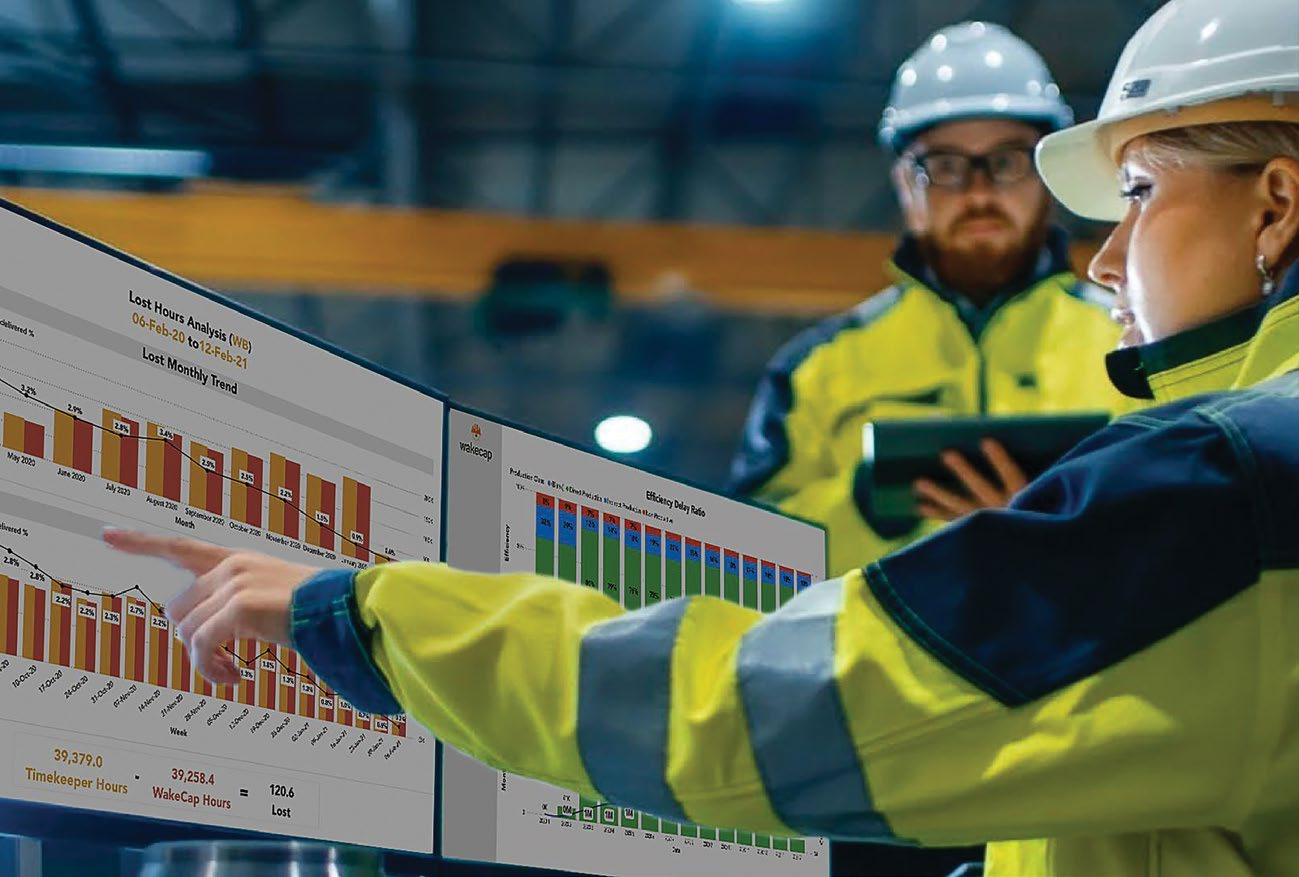
18 | CONSTRUCTION BUSINESS NEWS ME | AUGUST 2023 WWW.CBNME.COM CBNME OP-ED
valuable tool for improving construction site operations. But there remain to be challenges. Unfortunately, many projects suffer significant delays and cost overruns even with digitisation. According to a report from McKinsey & Co., 98% of large projects around the world experience cost overruns exceeding 30%. In Saudi Arabia, up to 82% of government projects have experienced delays, with costs exceeding 42% of the planned budget, according to a 2019 report from the Shura Council.
Addressing digitisation challenges in construction sites

By using the time and motion study technique, businesses can experience improved productivity and efficiency. This method is excellent for identifying areas for potential time-saving opportunities. At WakeCap, we see the value of transparency and visibility in the construction industry and the benefits it provides to everyone, from project owners to managers, consultants, and site workers, and we have made it our mission to revolutionise reporting. Our goal is to introduce accuracy, consistency, and transparency to tackle digitisation challenges in the construction industry, thus driving productivity. Our technology provides project managers with insights into what’s happening in their workplace. By collecting data from sensors that can easily be attached to hard hats and other
equipment, we can provide invaluable insights into the team’s productivity, safety, and efficiency. With easy-to-use interface software, this data can be interpreted in real time, empowering the team to address pain points. How to leverage the data we provide is up to the client – some use it for specific issues such as attendance, whilst others have asked us to help them identify problems they didn’t know they had. Our data reports on hours, headcount, attendance, etc., mitigate inaccuracies in manual reporting.
ENHANCES PRODUCTIVITY & EFFICIENCY
One area where WakeCap has been successful is in enabling site owners and managers to see notable improvements in productivity and efficiency. Our data analysis identifies common areas of wastage, including travel time, attendance, and unproductive hours. For example, we discovered that a team’s productivity significantly decreased when the foreman was absent from the site. Armed with this knowledge, one of our clients reassigned administrative tasks to another worker and saw a remarkable improvement in productivity, thanks to
the increased physical presence of the foreman.
IMPROVES SAFETY
Another area where WakeCap’s technology excels is safety, the most crucial aspect of any project. Our technology not only helps prevent accidents but also provides valuable data to enhance safety for workers and the site. The wearables allow for accurate tracking of the workforce on site, reducing incident reporting and emergency response times. In fact, one of our clients reported a 15% decrease in emergency response drills. In addition, the knobs our tamper-proof, shockproof, and waterproof with accurate sensorsensuring 100% PPE compliance.
SAVES TIME AND COSTS
We provide a clear picture of what’s happening on the construction site and what needs attention. Our real-time data on resource and time consumption enables project managers to optimise their projects so that they save money without compromising on delivery. By analysing our data, one major developer significantly reduced each worker’s non-productive hours from 3.5 hours to just 45 minutes. WakeCap data is considerably more accurate in identifying lost man hours.
The Middle East region has long been a leader in construction innovation. Ultimately, wearable technology is changing the game and the way we build. This shift has also enabled the construction industry to become more collaborative. By providing real-time data and analytics, everyone involved in a project can work together to ensure that tasks are completed on time and within budget. This information can be used for forecasting and planning purposes as well as for quality assurance. WakeCap has been adopted by more than 35 leading developments and projects across the region.
CONSTRUCTION BUSINESS NEWS ME | AUGUST 2023 | 19 REVOLUTIONIZING CONSTRUCTION IN THE MIDDLE EAST THROUGH WEARABLE TECHNOLOGY
“AT WAKECAP, WE SEE THE VALUE OF TRANSPARENCY AND VISIBILITY IN THE CONSTRUCTION INDUSTRY AND THE BENEFITS IT PROVIDES TO EVERYONE, FROM PROJECT OWNERS TO MANAGERS, CONSULTANTS, AND SITE WORKERS, AND WE HAVE MADE IT OUR MISSION TO REVOLUTIONISE REPORTING.."
THE KINGFIELD APPROACH
Kingfield’s notable tall projects
With the collaborative efforts of the team at Kingfield, we are successfully managing several vital projects across Dubai including mixed-use and residential communities. With regards to mixed-use, the most notable projects are The Sustainable City, Dubai’s first net zero city, and The Onyx Towers on Sheikh Zayed Road. On the other hand, we have the Torch Tower, Princess Tower and the Jumeirah Living Marina Gate within our portfolio of residential communities.

Empowering team, fostering independence, retention
On their first day on any project, on-site community managers are directed to treat the community as their “castle”, and they are given complete autonomy and accountability as if they were running their own business. This type of empowerment allows employees to be more innovative. Due to their authority over site operations and the ability to make crucial decisions that benefit their customers, they are motivated to actively explore innovative approaches for enhancing services within the community.
We encourage our employees to speak their mind and make suggestions that they believe will improve our services. At Kingfield, we make sure all relevant staff are involved in the decision-making process and that every voice is heard. That way, all team members understand that their opinions and ideas matter, which builds their self-confidence and enables them to innovate.
Kingfield’s pioneering OA Management
I believe that the key driver of our success is that we have always remained true to our fundamental principles and values despite the dynamic external conditions. Our approach is to prioritise the quality of our services above all else, and work towards achieving
the best attainable outcome for clients by focusing on the core job and not losing sight of critical day-to-day responsibilities.
Since the company’s inception, we made sure not to take on more responsibilities than we can handle, accepting tenders for one or two projects a year only and choosing our next assignment carefully. This approach enabled us to channel all our efforts on the projects at hand and provide fully dedicated management at each project, allowing us to grow at our own pace and build a reputation of excellence in the market.
Pro-active team upholds high standards
Achieving high-end customer service standards goes back to our employee empowerment strategy.
20 | CONSTRUCTION BUSINESS NEWS ME | AUGUST 2023 WWW.CBNME.COM
CBNME INTERVIEW
In conversation with Samer Khalifeh, Executive Director at Kingfield
Empowered employees are always on the look out for creative ways to enhance the services at their communities, because they recognise that they are in control and they have the ability to foster change and development.

By arranging regular face-to-face meetings between senior managers and on-site staff, we make sure employees handling the project are on the right track and that they are providing the standard of services that clients expect from Kingfield. These regular meetings serve as an engagement platform for team members to bounce ideas off each other and come up with new methods
ACHIEVING HIGH-END CUSTOMER SERVICE STANDARDS GOES BACK TO OUR EMPLOYEE EMPOWERMENT STRATEGY.
and tactics to refine the customer experience.
Kingfield drives innovation
As mentioned previously, we make sure that the on-site team and senior management meet faceto-face regularly to assess and review the situation at each project. The meetings give employees the chance to engage in collaborative brainstorming sessions, allowing them to make suggestions on all levels of the service delivery process, which helps in creating innovative solutions that add significant value for the client.
Another important strategy we employ is initiating the consulting phase with the developers at the design stage of new projects. This gives us the opportunity to highlight the challenges we encountered in previous projects from the operational point of view, and propose specific infrastructure enhancements that will prevent or hinder such issues. This will result in creating a more sustainable
development that provides enhanced services to clients, reducing operational hurdles and strengthening the developer’s image.
Kingfield integrates sustainability, creates new opportunities
One specific example of integrating sustainability principles with our consultancy services is evident in our work within the Jumeirah Living Marina Gate project.

In the Marina area, there was a recurring issue with parking for unloading trucks and the constant moving of people in and out of buildings. Recognising the problem, we proposed to the developer the implementation of a dedicated physical loading dock. This loading dock allows vehicles to drive in and efficiently drop off or unload items in the building without occupying parking spaces in the common area or disrupting traffic flow.
By implementing this solution, we have effectively addressed the parking and traffic challenges while promoting sustainability, creating new opportunities for an eco-friendlier environment around the project.
CONSTRUCTION BUSINESS NEWS ME | AUGUST 2023 | 21 THE KINGFIELD APPROACH | SAMER KHALIFEH
REVOLUTIONIZING CONSTRUCTION TECHNOLOGIES: THE FUTURE OF BUILDING IN THE MIDDLE EAST
 BY KASUN ILLANKOON
BY KASUN ILLANKOON
This construction feature focuses on exploring the latest advancements and cutting-edge technologies shaping the future of the construction industry in the Middle East. Companies had the opportunity to discuss and exchange ideas on the transformative technologies that are revolutionizing the construction process. This could include topics such as 3D printing, advanced construction technologie, modular construction, augmented reality, artificial intelligence, robotics, drones, and many more.
The content seen in this feature revolves around the benefits, challenges, and potential applications of these technologies in the Middle East construction sector. Companies share success stories, lessons learned,
and explore collaboration opportunities to leverage these technologies for improved efficiency, productivity, safety, and cost-effectiveness. The feature provides a platform to showcase innovative projects, highlight emerging trends, and inspire industry stakeholders to embrace and adapt to the evolving technological landscape in construction.
Participating in this feature are: LINQ, the modular construction focused subsidiary of the ALEC Group, Khansaheb, Atkins, a Member of SNC-Lavalin Group, Turner & Townsend, NEOM, TBH, EGIS Group, and China State Construction Engineering Corporation.
CBNME COVER

REVOLUTIONIZING CONSTRUCTION TECHNOLOGIES
LINQ
THE MODULAR CONSTRUCTION FOCUSED SUBSIDIARY OF THE ALEC GROUP

WHY MODULAR CONSTRUCTION IS PRIMED TO GO MAINSTREAM IN THE MIDDLE EAST
After a decline in 2020, an understandable consequence of the pandemic, the regional construction sector is once again on the upswing. According to the Royal Institution of Chartered Surveyors’ (RICS) Global Construction Monitor Q1 2023 report, the UAE’s construction sector remained “firmly positive” going into 2023, and this is expected to stay the case throughout the year.
In large part, this momentum is being driven by the concurrent boom in the region’s hospitality sector. According to recent projections, the hospitality market in the United Arab Emirates (UAE) is poised for an impressive 25% expansion by 2030. This growth is expected to drive the need for the addition of 48,000 new rooms to the existing stock. In neighbouring Saudi Arabia, the Holy Cities alone are expected to witness the addition of 110,000 units by 2030, in response to the high demand from pilgrims.
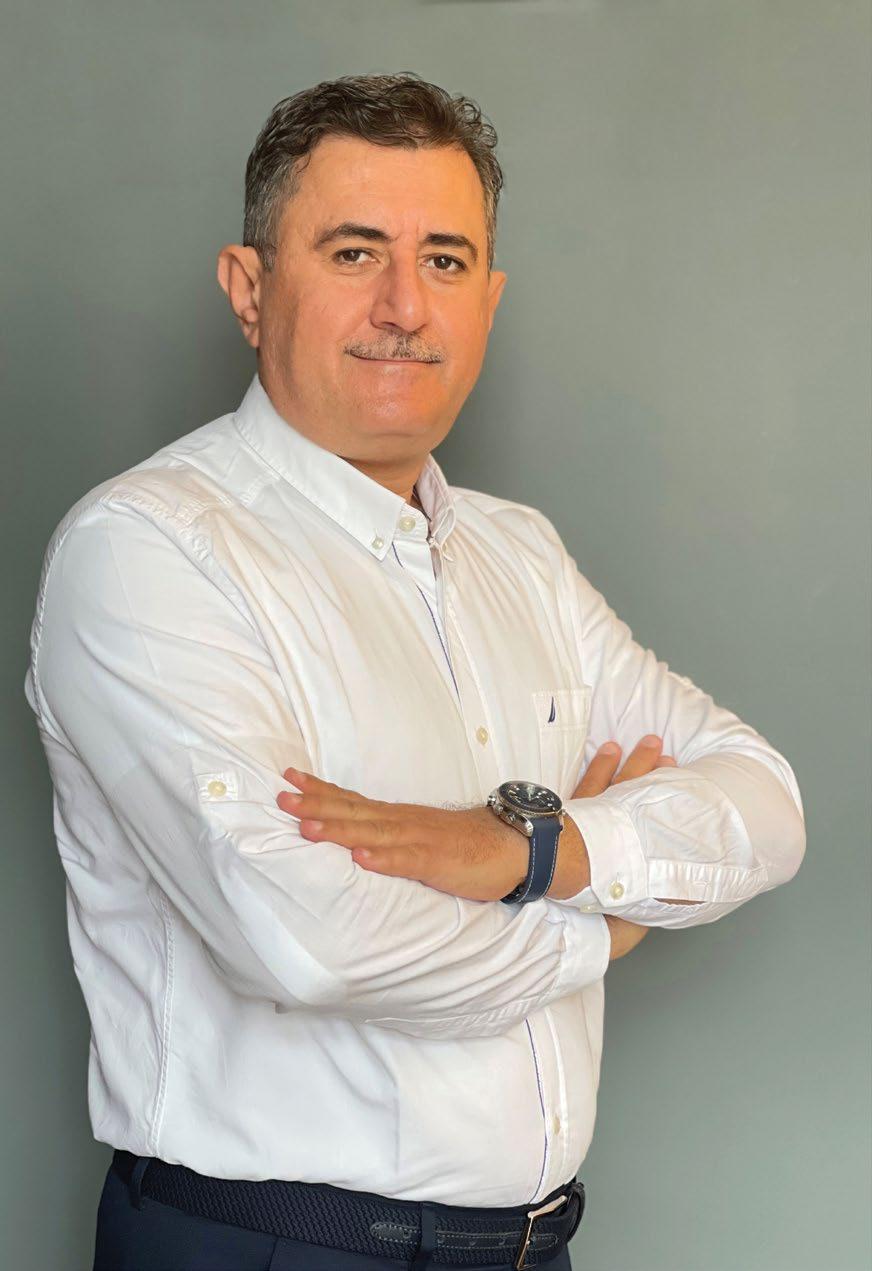
Fulfilling this demand will call for an accelerated pace of delivery. While this will no doubt mean plenty of opportunity for construction via traditional means to thrive, the readiness of public and private sector visionaries to embrace cutting edge technologies and techniques means that new methodologies will be presented with the opportunity to cross the chasm from promising concept to proven paradigm. Among these alternatives, few are likely to be as applicable and beneficial to the region’s needs of the hour as modular construction.
Changing Perceptions
With the roots of modern modular construction dating as far back as the 1800s, there has been plenty of room for extensive variation in quality, size,
24 | CONSTRUCTION BUSINESS NEWS ME | AUGUST 2023 WWW.CBNME.COM CBNME COVER
BASHAR KAYALI, General Manager at LINQ Modular
and design of units developed as per this approach. Consequently, this has resulted in some muddied, and arguably less-than-flattering perceptions of modular units (which have largely been utilised for residential purposes). While the application of modular construction for housing developments certainly presents an effective solution to the supply crunch currently witnessed in countries such as the United Kingdom, to focus on this application alone would be to miss the forest for trees.
Indeed, owing to the entry of some of the biggest construction players such as LINQ into the modular construction segment, modular units have come a long way in recent years. So too have the range of applications for which this approach can be feasibly applied. The Dubai Municipality awarding LINQ a licence to pilot the design and build of highly sustainable, customised modular G+6 units mark the first step towards large scale hotels and commercial towers being built in a modular fashion in the Emirate.

The use of top-quality materials, slick designs, and strict adherence to industry best practices have changed both the perception and the possibilities for modular construction.
Modern, in Development and Design

Leading construction players such as LINQ are committed to bringing to market offerings that set the highest benchmarks. As a result, increasingly, modern elements, high quality materials, and even impressive fitouts are being incorporated into modular units. And with today’s advanced fabrication technology now allowing for execution of extremely complex designs, prefabricated units – whether for commercial or residential purposes – have the potential to be as, if not more, affordable than their traditional counterparts. Not just this, they also have the potential to be more aesthetically appealing, and even more sustainable.
Quality and Sustainability
Building operations and construction account for nearly 40% of global energy-related CO2 emissions . With
the recent IPCC report highlighting the alarming impact of human greenhouse gas emissions, sustainability is the need of the hour in the construction sector .
By virtue of their design, modular units can be built with a higher percentage of sustainable material than units built from scratch on location. Furthermore, because modular units are produced off-site in purpose-built facilities, there is far more control than at a construction site. Such controlled environments allow for best practices to be stringently followed. Moreover, a high degree of repeatability can be introduced which translates to highly precise processes. All this translates to the potential for better utilisation of resources and less wastage, thereby offering a more sustainable approach.
Timely Delivery
Project delays are all too common in the construction sector — for construction companies this means unnecessary costs and for developers and end-users, a cause of great frustration. This too can be addressed by embracing the modular concept. The ability of modular construction techniques to effectively mitigate the possibility of project overruns stems from the fact that the factories
used to manufacture modular homes are designed around repeatability. Processes can be executed time and time again with laser sharp accuracy, and all the while, data and analytics being applied to uncover potential areas for optimisation. Because skilled labour is utilised at these production facilities, units can be fully fitted out and delivered to their final destinations in ‘near-ready’ conditions. Their installation requires a far lower degree of technical expertise, leading to faster installation on site, with a significantly reduced scope for error. In fact, modular manufacturing is so streamlined that it has been shown to accelerate project timelines by anywhere between 2050% .
With its modern refresh, modular construction is set to change the construction paradigm, bringing with it benefits through the entire value chain – from construction companies, to developers, community planners and most importantly building occupants. The UK, Singapore, Germany, Sweden, and Japan are all countries where modular construction is an important and well-established part of the industry. It’s only a matter of time before a larger number of nations recognise that the benefits of modular construction are no fabricated truth.
CONSTRUCTION BUSINESS NEWS ME | AUGUST 2023 | 25 REVOLUTIONIZING CONSTRUCTION TECHNOLOGIES
KHANSAHEB
BY DUNCAN PAYNE, GROUP SUPPORT SERVICES MANAGER
Digital Construction

The construction industry has been slower than other sectors to adopt technology, but it is gradually catching up. The pandemic compelled many to use new digital tools, which has made us more familiar and comfortable with digital systems. Because of this, and because of technological advancements and maturity in the underlying technology, there has also been a of a wave of digital solutions introduced in the construction industry. At Khansaheb we have developed a digital construction strategy to harness these technologies and improve our business. We are focused on enhance our performance, driving efficiency and ultimately benefiting all our employees, supply chain, clients, and other stakeholders.
One area of focus is information management which is critical for successful construction projects. When information is not managed well, it can lead to disputes and damaged relationships, with few real winners. At Khansaheb, we use digital construction tools that take advantage of technologies like BIM, digital twin, mobility, cloud, and advanced AI to capture and manage the flow of information in our business and construction projects. We collaborated extensively with Autodesk to establish Construction Cloud as the primary project management tool for all our projects. It serves as the digital platform where we handle all project-related information and processes. Consultants and subcontractors interact with us through this platform, while we create a comprehensive digital

26 | CONSTRUCTION BUSINESS NEWS ME | AUGUST 2023 WWW.CBNME.COM CBNME COVER
record of the project. It manages every model, drawing, specification, inspection, issue, photo, RFI, submittal, and transmittal in a single digital space, complete with approval and review workflows. Our engineers and project managers are empowered to be more self-reliant, as much of the administration that was previously involved in our projects has been eliminated. The platform works on mobile, tablet, and desktop devices, giving our staff the necessary tools when they are needed, which has resulted in less reliance on project offices and more time spent on-site managing the works.
Implementing new tools at this scale and complexity is a challenging task, which required overcoming many obstacles such as obtaining stakeholder agreement, training thousands of users, and promptly resolving issues to prevent users from reverting to old ways. Despite these challenges, the benefits have been significant, with measurable improvements in process speed and record accuracy. Additionally, we have seen notable improvements in more intangible areas, particularly in accountability, thanks to the transparency and accessibility provided by these tools.
Digital tools have made it possible for us to automate many processes, including reporting. One area where we have seen significant improvement is in the automated dashboard reporting we provide for our operational teams. With real-time access to critical project information like construction progress, safety alerts, project costs, manpower resources, and site equipment, our projects are safer and more efficient. We also use automation to reduce high-volume repetitive tasks in areas such as access control, data sharing, and device provisioning.
Recording progress on projects has traditionally been done by walking the site and capturing how much work has been completed, but this can be difficult when teams are in different regions or have limited time. That’s why we use a digital reality capture system from Openspace at our
projects. It captures 3D visualizations and uses advanced AI to map them onto layouts and models. We capture our projects in detail and view them in a split-screen setup, one showing the latest information and the other an earlier point in time. We use these visualizations to review progress, identify issues, and compare the real-world project with its BIM model. This helps us relate current progress to the design and resolve potential issues early on. We’ve already seen great benefits in reducing rework, improving subcontractor management, enhancing dilapidation surveys, and far better record-keeping by using this system.
We are currently working with the Openspace team to enhance our capabilities in using its advanced AI to measure progress in critical path trades, such as drywalling and MEP installations. We aim to automate comparisons of the measured progress with the planned progress. The system is so impressive that it may seem like technological witchcraft at first glance! Integration is a crucial aspect of our digital construction strategy. We understand that different systems and tools must work together seamlessly to ensure the smooth flow of information
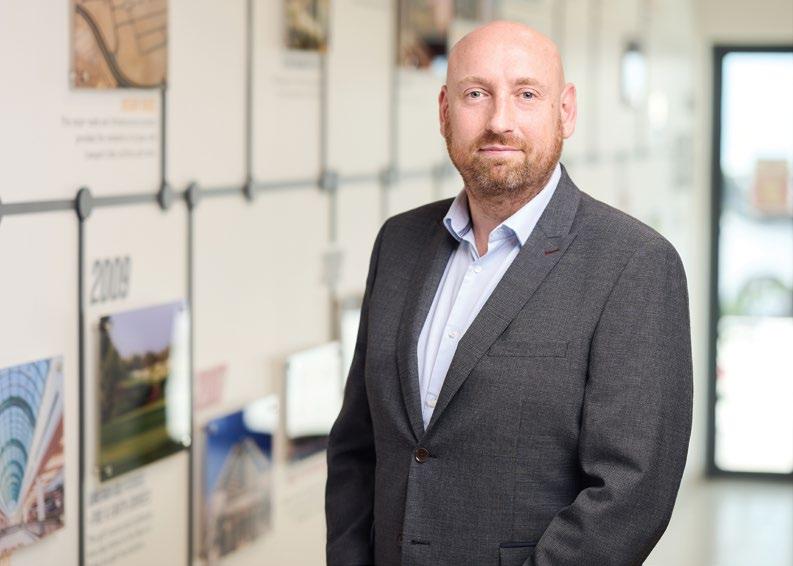

and data throughout all phases of a project. As a result, we have developed strong integration capabilities that have allowed us to connect multiple systems together, including our project management platforms, COINS our ERP system, and applications like human resources and time & attendance. Through these integrations we have managed to create a unified digital ecosystem for the business. This integration capability ensures that all our digital tools work together seamlessly, providing our teams with the correct information at the right time.
The construction industry is finally starting to catch up with other sectors in terms of adopting digital technologies. At Khansaheb, we have focused on information management, automation, and integration. By using tools like Construction Cloud, digital reality capture systems, and advanced AI, we have been able to improve process speed and accuracy, as well as increase accountability and safety on our projects. Our goal is to continue embracing new technologies and using them to drive efficiency and ultimately deliver better outcomes for our clients while maintaining our core values and relationships with stakeholders.
CONSTRUCTION BUSINESS NEWS ME | AUGUST 2023 | 27 REVOLUTIONIZING CONSTRUCTION TECHNOLOGIES
DUNCAN PAYNE, Group Support Services Manager
NEOM

BUILDING THE FUTURE: THE LINE’S TECHNOLOGICAL INNOVATIONS RESHAPING CONSTRUCTION IN THE MIDDLE EAST
 BY GILES PENDLETON, EXECUTIVE DIRECTOR OF THE LINE
BY GILES PENDLETON, EXECUTIVE DIRECTOR OF THE LINE
In a rapidly evolving construction landscape of the Middle East, transformative technologies are reshaping industry. From 3D printing to advanced construction techniques, robotics, and artificial intelligence, these innovations are driving efficiency and productivity. THE LINE is an ambitious project of unprecedented scale. It represents an extraordinary engineering feat encompassing a 170-km-long, 200-meter-wide, and 500–meter-high structure, ultimately housing 9 million residents within 34 square kilometers. Giles Pendleton, Executive Director of THE LINE, offers insights into the future of building in the Middle East and the pivotal role of technology in shaping the sector.
“The Middle East construction sector is embracing transformative technologies, enabling us to achieve improved precision, enhanced safety, and minimized environmental impact in construction projects.”
Realizing a transformational project such as THE LINE requires all engineers to be at the forefront of construction innovation. Our avant-garde spirit propels us to reimagine the very fabric of construction, forging a path of limitless possibilities. That’s why we continuously explore new construction methods, engage with industry leaders and invest in research and development to unlock the full
potential of emerging technologies. Here are some of the modern construction methods we are deploying as we build the largest structure on Earth:
Modular construction, our secret ingredient to speed and quality. Just like building blocks, we are fabricating building components off-site, ensuring consistent quality control, reducing waste, improving safety and reducing carbon. This approach significantly accelerates construction timelines and delivers high standards of delivery, enabling us to construct with precision and efficiency. It also provides the flexibility to answer future city needs seamlessly by allowing us to plug in and out new modules and city components as required.
Digital twin, a parallel world where we optimize before we build. Think of it as a virtual rehearsal. By creating digital replicas of our buildings and infrastructure, we can simulate and optimize their performance before construction begins. We identify and address design flaws, refine energy efficiency measures, and streamline operations while gaining exceptional transparency to enable predictive maintenance. 3D printing, the sculptor of the future. With 3D printing, we can create intricate structures with unparalleled precision and speed. It’s like a sculptor’s dream, but we use advanced materials instead of clay to bring our architectural visions to life. This technology boosts construction efficiency, reduces material waste, and unlocks new design possibilities that were once unimaginable.
Augmented reality (AR), a vision into the future. With AR, we enhance planning, design coordination and onsite decision-making, allowing us to visualize different design options, detect clashes and collaborate effortlessly with project stakeholders. This technology enhances efficiency and accuracy throughout construction, turning our visions into reality.
Robots, a tireless addition to the workforce. We are advancing the use of robotics and automation to deliver faster, better, and safer construction. One earlyuse case that our team is accelerating is the automation of rebar cage assembly, where preliminary results demonstrate a 10x improvement of productivity and a reduction in the workforce required for reinforcement by 80%. >>>
28 | CONSTRUCTION BUSINESS NEWS ME | AUGUST 2023 WWW.CBNME.COM CBNME COVER

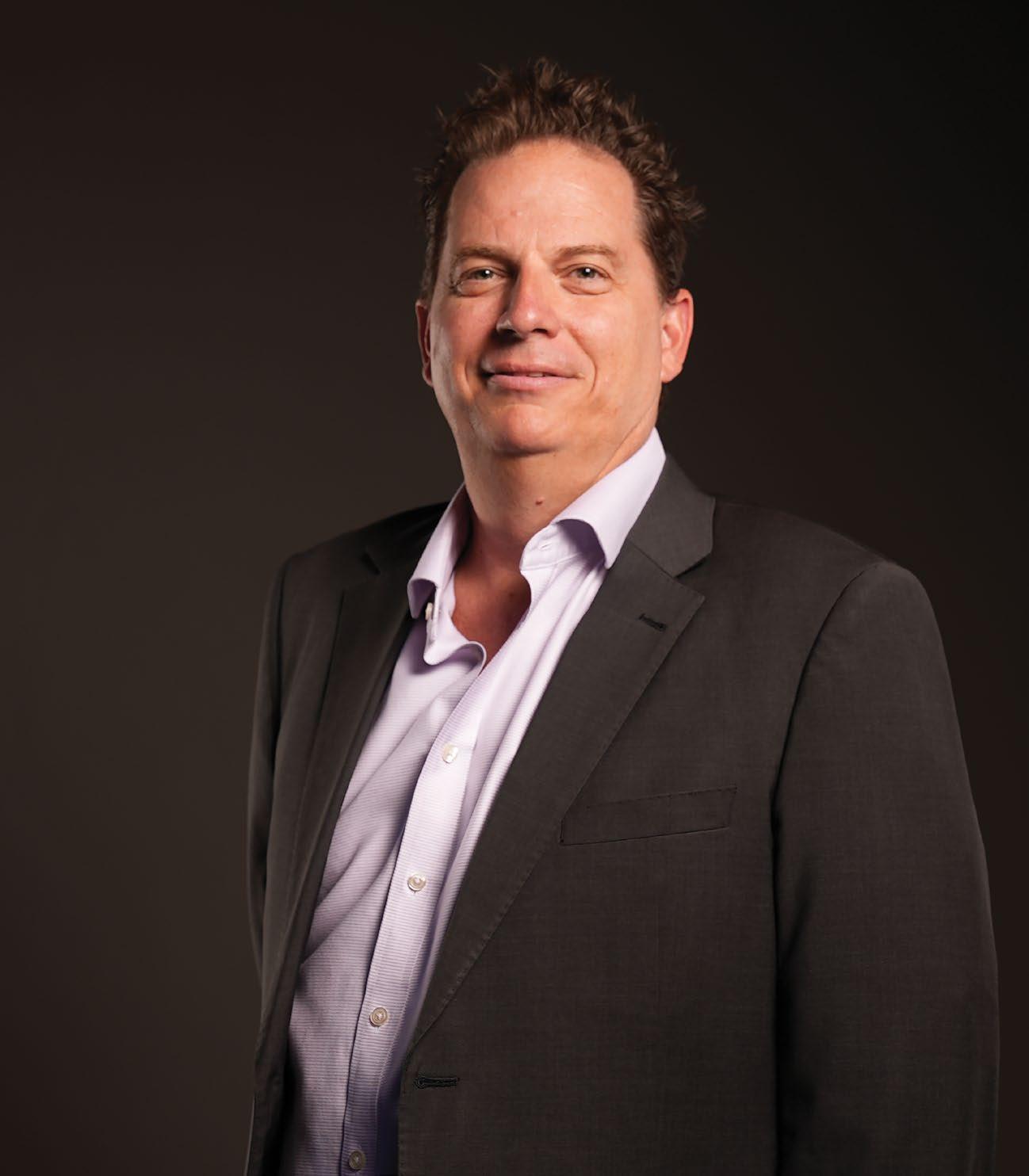
CONSTRUCTION BUSINESS NEWS ME | AUGUST 2023 | 29
CONSTRUCTION TECHNOLOGIES
REVOLUTIONIZING
GILES PENDLETON, Executive Director of THE LINE
Artificial intelligence (AI), Creating the largest and most ambitious structure in the world requires the best of human and artificial intelligence. We aim to use powerful AI capabilities across the urban development lifecycle, from planning and design to construction and eventually into operations and maintenance. This will include optimizing the asset mix and land use, iterative architecture design, efficiently managing costs schedules and the supply chain Drones, our eyes in the sky. We are deploying unmanned aerial vehicles to provide accurate visual data, enabling us to closely monitor construction activities, identify potential issues and ensure adherence to project timelines. They act as our eyes in the sky, enhancing productivity and safety on our construction sites.

By incorporating these advanced construction methods and technologies, THE LINE project sets new benchmarks
for sustainable and innovative urban development. It also catalyzes future construction in the Middle East by acting as a testbed of groundbreaking technologies, paving the way for widespread deployment across the region and beyond.
“Collaborative efforts among industry stakeholders can unlock new opportunities and mutual benefits in adopting transformative technologies for construction projects.”
Many construction projects in the Middle East, including THE LINE, offer significant potential for collaboration, knowledge sharing, and partnership opportunities to adopt transformative technologies. All industry stakeholders must come together to explore and leverage future technologies. For instance, stakeholders can establish research and development centers dedicated to testing and refining

30 | CONSTRUCTION BUSINESS NEWS ME | AUGUST 2023 WWW.CBNME.COM
COVER
CBNME
emerging construction techniques. By pooling resources and investing in cutting-edge equipment and software, they can create testbeds to pilot innovative solutions tailored to the region’s specific challenges.
Regulatory and government bodies are essential in creating an enabling environment for technology adoption. They can encourage widespread take-up by standardizing practices, streamlining approval processes, and providing incentives for green and smart construction methods. Through collaborative efforts, industry stakeholders tap into a collective intelligence that fuels innovation, knowledge sharing and accelerated adoption of transformative technologies.
“Sustainable and smart city designs, adoption of robotics and automation, and the integration of artificial intelligence are emerging trends shaping the future of construction in the Middle East.”


THE LINE exhibits intelligent infrastructure, eco-friendly design principles, sustainable construction methods, and renewable energy integration. Technology is omnipresent throughout all construction phases. For example, robotics and automation revolutionize construction sites by boosting productivity and ensuring safer working conditions. Robots take on repetitive tasks, reducing the risk of accidents,
while automation streamlines workflows for precision and speed. Additionally, artificial intelligence can optimize project management, site safety and data analysis by proactively detecting hazards, predicting risks and enhancing real-time safety measures. It also facilitates predictive maintenance for seamless operation and upkeep. THE LINE also embodies future-proof infrastructure, ready to integrate upcoming technologies, representing a paradigm shift in urban development that never becomes a legacy burden in the future.
“Through technology adoption, digital transformation, and industry partnerships, the Middle East construction sector is unlocking its full potential and leading the way in building excellence.”
Construction technology advancements are reshaping the Middle East’s building industry, paving the way for a sustainable and technologically advanced future. THE LINE project is a remarkable example of sustainability, innovation, and collaboration. The possibilities are endless, and by adopting advanced construction methods, embracing digital transformation, and fostering industry partnerships, the Middle East construction sector can unlock its full potential and continue leading the way in building excellence in this dynamic era.
CONSTRUCTION BUSINESS NEWS ME | AUGUST 2023 | 31 REVOLUTIONIZING CONSTRUCTION TECHNOLOGIES
TURNER & TOWNSEND
EMBRACING A NEW, DIGITAL ERA FOR CONSTRUCTION
 BY HILAL ASSFOUR, PRINCIPAL CONSULTANT, TURNER & TOWNSEND
BY HILAL ASSFOUR, PRINCIPAL CONSULTANT, TURNER & TOWNSEND
Middle East Construction activity demonstrated remarkable growth exceeding $200 billion in 2022, with projections estimating a further 4% growth for the industry in both KSA and the UAE. (GlobalData 2023). Considering the ongoing expansion of in-region real estate and infrastructure projects, the construction market is now thriving at unprecedented levels. This has brought about emerging challenges relating to cost, time, and quality, all of which can be managed through the successful utilisation of technology and digital tools.
Addressing the challenges
Technology, when adopted and implemented under a comprehensive digital framework, can bring about significant added value. The advantages of technology applications within construction are widely recognised and acknowledged. Modular construction has proven its ability

to significantly reduce construction times, mixed reality technology is being used for training purposes to enhance safety measures at construction sites, the utilisation of machine learning algorithms enhances design optimisation as it leverages the power of historical data, and the use of cloud solutions allows for effective communication and exchange of data among stakeholders. While certain constraints such as implementation cost, lack of awareness, and lack of skilled resources can hinder the application of these modern technologies and thus significantly decrease the gained value, the specific characteristics which make up the middle east market, impose even further challenges that require addressing.
TIME CONSTRAINTS: The middle east construction market is known for challenging timeframes for project durations, and technology can add to these. In fact, incorrect technology application combined with the lack of experience can extend
32 | CONSTRUCTION BUSINESS NEWS ME | AUGUST 2023 WWW.CBNME.COM CBNME COVER
project delivery duration. Over the years, I have observed major developers opting to skip essential technology implementations due to this perceived risk of added time, however this can be mitigated through proactive risk management.
LACK OF DIGITAL STRATEGY: inspired by the digital transformation programmes that in-region governments are rolling out, increasingly, we are seeing an appetite by developers for the embracement of construction technologies on their projects. Some firms are even willing to invest significant funds for these technologies, be it as a compliance to governments technology mandates, or by their drive to be at the forefront of digital transformation, where the adoption of technology and digital tools is perceived to bring about significant positive impacts on projects such as cost savings, programme advancements, or quality improvements. That said, we have also witnessed significant failures and limited benefits when technologies are applied without appropriate digital assessments or well-defined strategies. To achieve results that align with the overall vision for a development, it is crucial that clear expectations are set and that planned steps are then taken towards achieving value-driven implementation.
DATA SECURITY: Recent construction technologies tend to depend on or involve data processing and cloud solutions that are hosted by servers located overseas. Government and semi-government entities in the middle east tend to adopt a conservative approach dealing with cloud data solutions, and they are cautious about projects data being hosted by third-party cloud service providers.


CONSTRUCTION BUSINESS NEWS ME | AUGUST 2023 | 33 REVOLUTIONIZING CONSTRUCTION TECHNOLOGIES
>>>
HILAL ASSFOUR, Principal Consultant, Turner & Townsend
WE HAVE SEEN FROM GLOBAL EXAMPLES THAT GOVERNMENTS ARE IN THE BEST POSITION TO DRIVE NATION-WIDE DIGITAL CONSTRUCTION TRANSFORMATIONS. BOTH THE UAE AND KSA GOVERNMENTS ARE ALREADY TAKING REMARKABLE STEPS TOWARDS ACHIEVING DIGITAL TRANSFORMATION ON ALL LEVELS.
As a result, they often opt to manage construction and project specific data using on-premises data storage to maintain control over their data assets. Investing in data processing/ cloud-based platforms that offer local cloud hosting, will enable the regional construction industry to fully utilise innovative technologies whilst providing assurance that project data is governed at a local level.


THE ABSENCE OF AN INTEGRATED FRAMEWORK: Insufficient consideration of project lifecycle needs and the absence of an integrated framework that effectively integrates these technologies together, is a major challenge that we tend to overlook, though it is the key to successful digital transformation in our industry. The lack of a framework that holistically incorporates new, digital technologies, leads to a significant cost and time loss as well as a missed opportunity to maximise potential and derive substantial value that correct implementation could achieve.

34 | CONSTRUCTION BUSINESS NEWS ME | AUGUST 2023 WWW.CBNME.COM
COVER
CBNME
One example is the relationship between Building Information Modeling (BIM) and digital twins in the construction industry. When BIM serves as the backbone for digital twins, it allows for the utilisation of preexisting models and associated data to enable digital-twins-based facility management solutions. This integration can be further enhanced by incorporating Internet of Things (IoT) technologies, which provide real-time operational asset data within a 3D environment. This integration of multiple technologies is not an easy task, and it requires major cooperation from all entities.
A top-down approach
We have seen from global examples that governments are in the best position to drive nation-wide digital construction transformations. Both the UAE and KSA governments are already taking remarkable steps towards achieving digital transformation on all levels, and it is expected that the construction industry will be positively impacted by these trends. Examples of these initiatives include drone and digital twin programmes by Dubai Municipality, as well as Department of Municipalities and Transport’s Abu Dhabi Digital Twin Project. We have also seen multiple initiatives of 3D printing and BIM mandates in both emirates. In the Kingdom of Saudi Arabia, developers have also adopted BIM
across the majority of Public Investment Fund (PIF) backed major/ giga projects and schemes.
While the vision for a digitally transformed construction industry is being established, developers can support the transition by providing their supply chain and private sector stakeholders structured guidelines to work to. Creating clear channels of collaboration will also enable and encourage effective contributions to wider digital transformation strategies such as city-wide digital twin programmes.
Embracing a digitally charged era in construction
While technologies can address many of our industry’s challenges, aligning integrated technology solutions with a clear vision is essential, and adopting a top-down approach, starting from government and major developers down to delivery teams will achieve the most successful outcomes.
While keeping a digital-first approach in mind, governments, developers, and contractors should work together to create sustainable infrastructure and overcome emerging challenges related to data security by investing in cloud solutions that offer local cloud hosting.
Looking ahead, the market is expected to witness an increase in government-backed, sustainability-driven programmes where technologies such as AI, Modular Construction, and Digital Twins will play a significant role.


CONSTRUCTION BUSINESS NEWS ME | AUGUST 2023 | 35 REVOLUTIONIZING CONSTRUCTION TECHNOLOGIES
CHINA STATE CONSTRUCTION ENGINEERING CORPORATION (CSCEC)
 INNOVATION DRIVE FOR FUTURE PROOF CONSTRUCTION
BY MANSOUR FARIED, CHIEF ENGINEER, HQ ENGINEERING DEPARTMENT
INNOVATION DRIVE FOR FUTURE PROOF CONSTRUCTION
BY MANSOUR FARIED, CHIEF ENGINEER, HQ ENGINEERING DEPARTMENT
The CSCEC ME Technical conference since it has been launched for the first time in 2017, has witnessed an evident progressive success year after year, proven by the growth of number and categories of attendees, as well as the expansion in the event scope and target audience, to the extent that it became part of the company branding and a long-awaited annual event internally and externally. Since the fourth round happened last year, we have swapped into the virtual event basis in respect to local guidelines and restrictions related to Covid 19 outbreak, and it is the same case also in this fifth round of the conference. However, we have taken the advantage of such mandatory change to implement an innova-
tive platform to host our event for a richer user experience based on real interaction, as well as maximizing the accessibility of our event to construction experts in the local market for the maximum benefits, accordingly. It was a real pleasure to welcome our esteemed guests from local government entities, clients, consultants and academic institutes, in addition to our primary target audience who are CSCEC ME staff.
The conference theme of this year is “INNOVATION DRIVE FOR FUTURE PROOF CONSTRUCTION “, this theme has been selected and developed after we hear a lot complains in various events about how construction industry is one of the largest industries worldwide with a massive contribution to carbon footprint and CO2 emission, and yet, it has
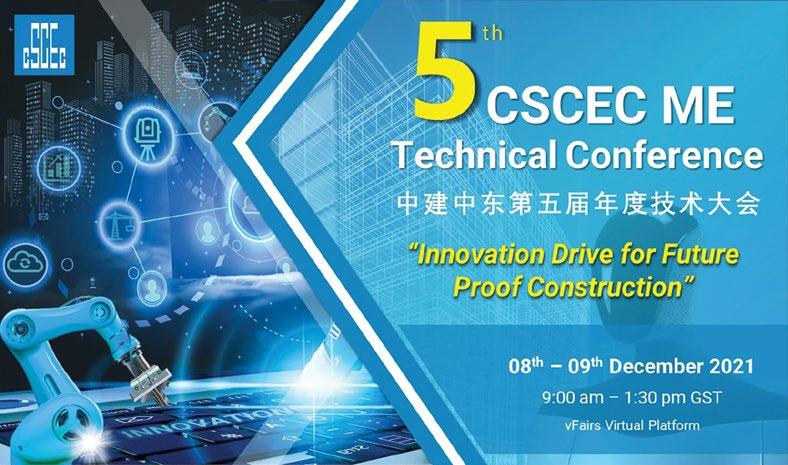
been seen as the least among other industries in terms of innovation, spends on R&D and digitalization.
The above statement has raised two major Questions; “How” and “Why”? how construction is seen among the least innovative industries compared to others? And why it is like that?
To answer the first question, the “How”, we need to look deeply into the achievement of other industries so we can feel the difference, lets take the aviation industry for example, over the past three decades, the concept of composite materials, like carbon fibers, has been a real game changer in the industry, it has been widely adopted by both major industry players like Boeing and Airbus, due to huge operational and safety benefits it adds, replacing the majority of metal components and joints by larger monolithic segments which is safer, and more durable.
Other industry can also be observed is the Automotives, the introduction of the conduction motor in the electric cars is another game changer, where such elements has also replaced the conventional compassion engine along with gear box, leading to more powerful cars, less requirement of regular maintenance and by far great reduction of CO2 emission.
Now let’s look back on the construction industry and ask ourselves, when was last game changer innovation seen in the industry? Eventually we may find that happened when the reinforced concrete was invented one and half century back.
36 | CONSTRUCTION BUSINESS NEWS ME | AUGUST 2023 WWW.CBNME.COM CBNME COVER
Then the second question became more critical, “why” disruptive innovations are not really seen happening in construction industry compared to others?


Looking into several research eagerly aimed to answer this question, we can conclude three main reasons for that phenomenon; namely the “nature of Deviation”, “the nature of the product” and “the Risk and opportunity moral hazards”, we will explore each of them in the following few lines:
The Nature of Deviation:
Based on three different researches used simple analytical method to measure the chances of projects to meet their estimated budget and duration based on actual performance data, the distribution of the projects on the normal distribution graph shows an interesting fact, the curve in all the three studies was “ Right skewed curve” , means compared to bench mark budget and base line Programme, the number of project which went above budget and behind the schedule are by far much more that than the number of project who performed under budget and ahead of schedule, not only that, the results plot on a standard scatter plot of the actual cost compared to budget found to be “fat Tailed”, means there was a considerable number of projects who went extremely far from the preset budget and time by multi folds.
To summaries the above, those studies proven that the construction projects are most likely go wrong than being right, and when it goes wrong, it can be extremely wrong.
With the magnitude of investment in construction industry compared the size of the Companies involved, it is evident that the associated commercial risk is significantly high and one project failure could be enough for many stakeholders to collapse, accordingly construction decision makers are unlikely to venture less driven roads. >>>

CONSTRUCTION BUSINESS NEWS ME | AUGUST 2023 | 37 REVOLUTIONIZING CONSTRUCTION TECHNOLOGIES
MANSOUR FARIED , Chief Engineer, HQ Engineering Department
The Nature of the Product:
Looking in the product of construction industry, we can see some obvious and unique characteristics which the large number of stakeholders are engaged in decision making, as well as the very long design life expected for the final products. Those decision makers are including developers, designers, builders, authorities, and end users, all of them are co-decision makers for a product to be used by next 2 or 3 generation. Such unusual setup is negatively impacting the innovation ability of any of the decision makers, and reduce chances for major changes to happen.
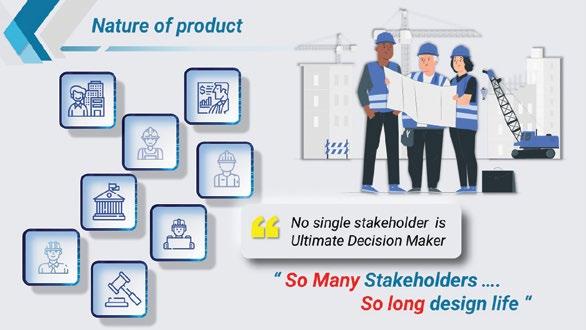
“The Risk and opportunity moral hazards”
Here is another fact about innovation process in construction industry, which indeed not isolated from the previous two reasons, the Innovation champions in construction field are under a sort of reverse moral hazard, when the innovation succeeded, the benefits accrue to the rest of the project team, but eventually if it failed, the risks and the blame will accrue only to them. This mechanism adds


up more reluctance to the innovators to step forward, and notably slow down the innovation process in construction projects.
Summary and Conclusion:
From all of the above, we can conclude that the construction has a special nature compared to others, it is associated with a high magnitude of investment which is proven to be subjected to high commercial risk, and for innovation to happen in construction project, a real collaboration form all
WITH THE MAGNITUDE OF INVESTMENT IN CONSTRUCTION INDUSTRY COMPARED THE SIZE OF THE COMPANIES INVOLVED, IT IS EVIDENT THAT THE ASSOCIATED COMMERCIAL RISK IS SIGNIFICANTLY HIGH AND ONE PROJECT FAILURE COULD BE ENOUGH FOR MANY STAKEHOLDERS TO COLLAPSE
stakeholders are essentially required, specially when it comes to risk sharing, it is worth also to note that the innovation in construction is most likely happen incrementally ( step by step), rather than disruptive.
In CSCEC ME, we foresee the Innovation in construction project through four main pillars; Automation,
Digital transformation, Offsite fabrication and Green construction. And accordingly, we have carefully selected the all the topics of this fifth conference to be around one or more of those pillars. Looking forward to promote the innovation culture within the company and the entire local construction market here in Middle East.

38 | CONSTRUCTION BUSINESS NEWS ME | AUGUST 2023 WWW.CBNME.COM CBNME COVER




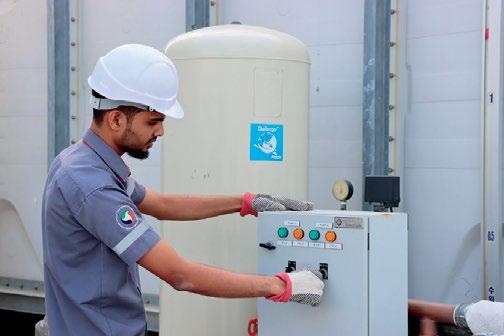
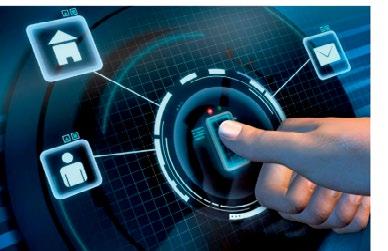










Excellence in Customer Service INNOVATIVE FACILITIES SOLUTIONS www.emiratesnfm.com Call us : 800 3200 M A N A G E S 1 0 0 0 + S I T E S A C R O S S T H E U A E ALL UNDER ONE ROOF
EGIS GROUP

AI: THE ARCHITECT OF CONSTRUCTION TRANSFORMATION
 BY ASMAA ABOULEISH, BIM MANAGER, EGIS SAUDI ARABIA
BY ASMAA ABOULEISH, BIM MANAGER, EGIS SAUDI ARABIA
As we delve into the world of AI in construction, let’s begin by demystifying this transformative technology. AI, short for Artificial Intelligence, represents the simulation of human intelligence by machines. AI has mainly three types: Supervised Learning, where AI models learn from labeled data; Unsupervised Learning, where AI models find patterns in unlabeled data; and Reinforcement Learning, where AI models learn through trial and error. These types enable AI systems to acquire knowledge and make decisions.
Supervised learning
Supervised learning in construction can be leveraged to predict energy consumption patterns, enabling construction companies to optimize energy usage and implement energy-efficient strategies. Historical data can also be utilized for accurately predicting project prices,
enabling construction companies to estimate costs and make informed budgeting decisions. These use cases enhance resource allocation and support effective decision-making in the construction industry.
Unsupervised learning
Unsupervised learning in construction provides valuable applications such as identifying defects in construction materials. By analyzing unlabeled data, AI models can detect subtle patterns or anomalies in materials, enabling early identification of defects and ensuring higher construction quality. By analyzing historical data, AI models can uncover hidden issues or patterns that contribute to project cost overruns, enabling more accurate cost estimation and budget planning. These applications assist construction professionals in mitigating risks, making informed decisions, and improving overall project performance and cost-effectiveness.
40 | CONSTRUCTION BUSINESS NEWS ME | AUGUST 2023 WWW.CBNME.COM CBNME COVER
Unsupervised learning proves invaluable for cost-effective data analysis. By leveraging advanced algorithms, it enables precise identification of relevant data points, guiding the construction companies on what to measure precisely. This focused approach ensures efficient resource allocation, maximizes data value, and enhances decision-making processes. Unsupervised learning empowers construction to extract meaningful insights from data while minimizing expenses, making it a crucial tool in optimizing data collection efforts.
Reinforcement learning
Reinforcement learning in construction offers practical use cases. Firstly, it can be applied to optimize construction equipment operations. By training AI models through trial and error, autonomous construction equipment such as robots or drones can navigate construction sites, perform tasks with precision, and enhance overall efficiency.
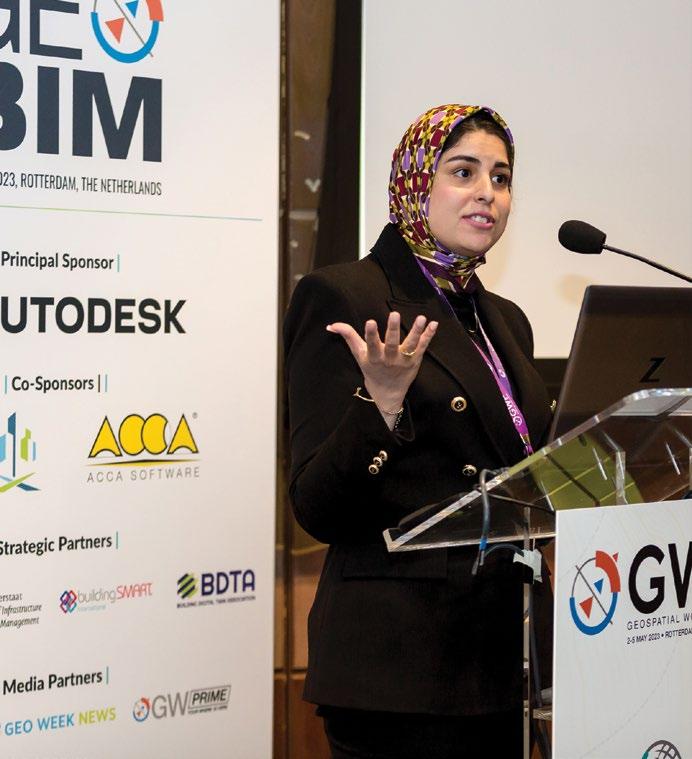
Secondly, reinforcement learning can assist in schedule optimization. AI models learn from feedback in the form of rewards or penalties, enabling them to make informed decisions about resource allocation and task sequencing.
Let us deep dive and know how Reinforcement learning (RL) works to optimize schedules. It assigns rewards based on predefined criteria by us. For example, the reward can be based on completing tasks within allocated time
frames, minimizing resource conflicts, or achieving project milestones. The AI model learns through trial and error, exploring different scheduling strategies and receiving rewards for desirable outcomes.
During the learning process, the model adjusts its decisionmaking to maximize the rewards it receives. Through iterative iterations, the reinforcement learning algorithm discovers optimal scheduling solutions that minimize delays, optimize resource utilization, and adhere to project constraints. By fine-tuning the reward structure and incorporating domain-specific knowledge, reinforcement learning algorithms can effectively optimize construction schedules enhance automation, improve project timelines, optimize resource management, and improve overall project efficiency.
Generative AI

In addition to the previous AI types, there is a generative AI like Midjourney. By using text prompts, Midjourney can generate images that find practical applications in architecture and construction. It enables exploration of conceptual designs, aids in project visualization, and assists with material selection. Figure 1 shows how Midjourney could be used to create conceptual designs.
Challenges
Implementing AI in construction poses several challenges. Limited availability and quality of data, as well as data silos, hinder AI model training. The industry’s traditional practices and resistance to change also impede adoption. Lack of skilled workforce proficient in AI and the need for substantial investment in infrastructure and technology further add to the challenges. Overcoming these hurdles requires addressing data issues, promoting a culture of innovation, upskilling the workforce, and establishing a clear AI implementation strategy that aligns with the unique requirements of the construction sector.
To implement AI, there are typically four key implementation processes: Intelligence, Business Process, AI Technology, and Development. In the Intelligence stage, a specific behavior that AI can perform is identified. Next, in the Business Process stage, a business process is defined that incorporates this behavior. Then, in the AI Technology stage, the AI solution and data strategy are determined. Lastly, in the Development stage, a software development plan is devised, addressing known AI issues (AI cancers). These processes, by MIT xPro, provide a structured approach for successful AI implementation within a concise framework.
In conclusion, the integration of AI in construction holds immense potential for improving efficiency, quality, and decision-making. Supervised, unsupervised, and reinforcement learning enable enhanced quality control, predictive maintenance, resource allocation, risk mitigation, and schedule optimization. Overcoming challenges like data limitations and resistance to change is crucial for successful AI implementation in construction, ultimately leading to safer, more efficient, and sustainable projects.
CONSTRUCTION BUSINESS NEWS ME | AUGUST 2023 | 41
REVOLUTIONIZING CONSTRUCTION TECHNOLOGIES
ASMAA ABOULEISH, BIM Manager, Egis Saudi Arabia
EMBRACING THE DIGITAL TRANSFORMATION OF CONSTRUCTION IN MIDDLE EAST
 BY ANIL IPEKCI, ASSOCIATE DIRECTOR AT TBH
BY ANIL IPEKCI, ASSOCIATE DIRECTOR AT TBH
In 1999, while we were graduating from using floppy disks to CD-ROMs in our Intel Pentium computers, the amazing computer game, “Unreal Tournament”, was released. It was a game which revolutionized the video game industry with realistic graphics that were beyond its era. This was the first time I heard about “Unreal Engine”, a powerful gaming engine.
Today, many of us in the construction industry have heard about this since gaming engines are used to benefit 4D planning animations, architectural designs with enhanced customer experience and even in the visualization of construction disputes.

As a Planning and Project Controls specialist with over fifteen years of experience in the construction industry, I can say that we do tend to look for ways to automate our manual, daily tasks. Being an admirer of innovative and disruptive technologies, I often consider how new technologies can benefit our field.
I recall reading a LinkedIn post about a company using machine learning technology to utilize the existing surveillance cameras on a construction site to identify the movement of excavators and monitor the excavation progress by measuring the differences in volume. It was such a brilliant idea, and it expanded my interest in construction technologies.
The Middle East is a great place to be the first to witness new technologies being tested. Over the past few years, with multiple challenges such as the global pandemic, an inflationary environment and reduced capital expenditure post World Cup, the market has pushed the industry to be more change adaptive. Some of the challenges we face are destined to be addressed with technological innovations. Governments in the region are progressively focusing on moving away from being oil-centric economies and diversifying with continuous adoption of innovative digital technologies. A good example of this was a decree issued
42 | CONSTRUCTION BUSINESS NEWS ME | AUGUST 2023 WWW.CBNME.COM CBNME COVER
TBH
in the UAE regulating the use of 3D printing in Dubai’s construction sector (Decree No. 24 of 2021), with a target of having 25% of the buildings in the region constructed using 3D printing technology.
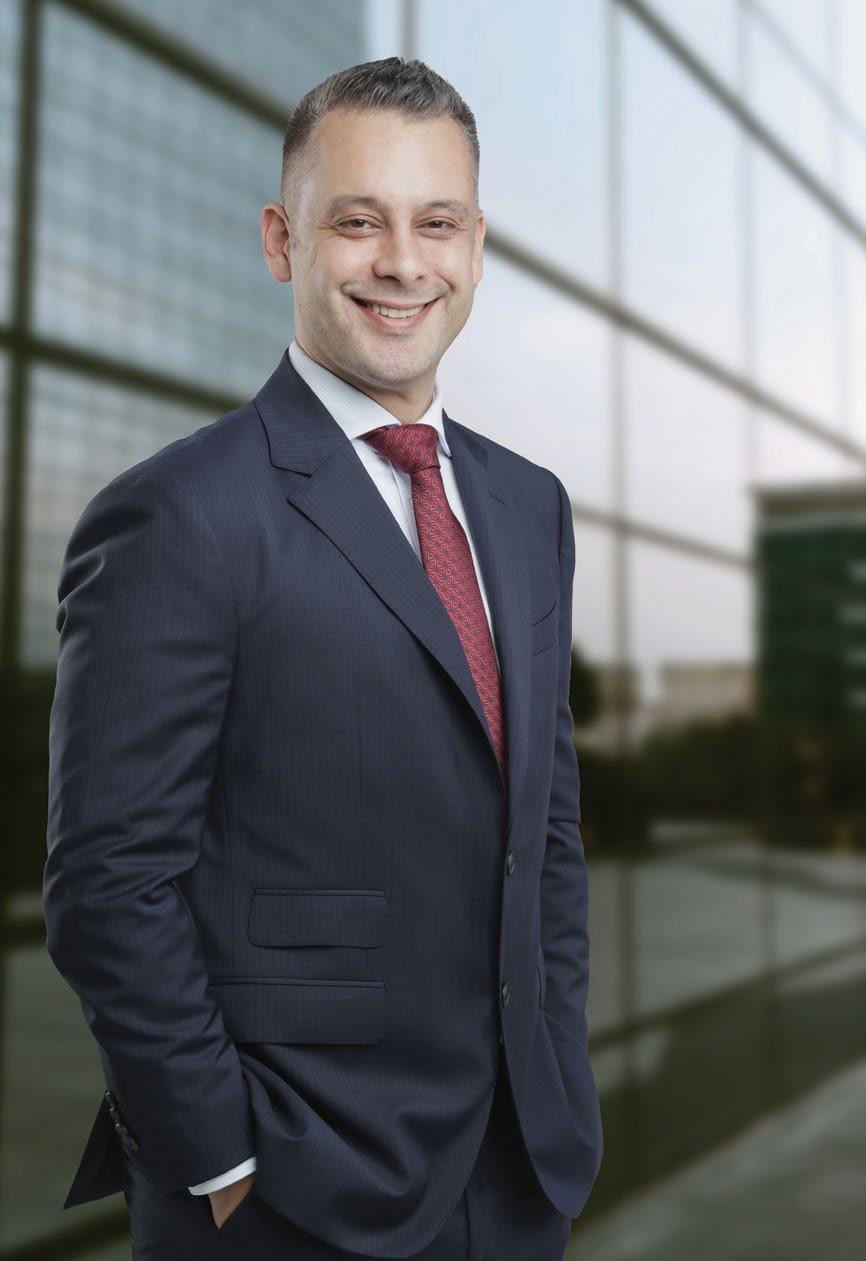
It can be challenging to keep up with the number of new developments! In this article, I will highlight a few examples and consider what they can offer our industry.
I RECALL READING A LINKEDIN POST ABOUT A COMPANY USING MACHINE LEARNING TECHNOLOGY TO UTILIZE THE EXISTING SURVEILLANCE CAMERAS ON A CONSTRUCTION SITE TO IDENTIFY THE MOVEMENT OF EXCAVATORS AND MONITOR THE EXCAVATION PROGRESS BY MEASURING THE DIFFERENCES IN VOLUME.
Project Planning
&
Controls: There are revolutionary applications of Artificial Intelligence (AI) in Project Planning and Controls.
By utilizing AI and machine learning, construction professionals can automate tasks, optimize schedules, and identify potential issues with greater speed.
AI and machine learning solutions are used to monitor and prioritize risks at site, evaluate job progress and provide instant updates on workforce and equipment.
Robots contribute to safety, with algorithms analysing site photos for hazards and assessing risk ratings.
Artificial Neural Networks are employed to predict cost overruns and provide realistic forecasts for future projects considering factors like project type, size, and staff competence.
Do you think an algorithm could determine the competence of a Project Manager?
Transforming Mundane Tasks with Generative AI:
Advanced AI language models, such as ChatGPT, Bard or Claude, are being adopted in various industries. We can expect to see the integration of these models with other technologies more in the near future, which may enhance human-AI interaction and promote innovative and creative solutions for construction projects. It is possible to come across some frontier construction companies who have started testing these models for:
> A centralized location with enhanced stakeholder collaboration
> Creating construction schedules and automating progress tracking >>>

CONSTRUCTION BUSINESS NEWS ME | AUGUST 2023 | 43 REVOLUTIONIZING CONSTRUCTION TECHNOLOGIES
ANIL IPEKCI, Associate Director at TBH
> Improving documentation and record keeping
> Coding for project and task specific software creation
> Generating cost estimates and forecasts.
Internet of Things (IoT) for Smart Construction:
IoT devices and sensors are being integrated into buildings and infrastructure, enabling real-time data monitoring and analysis. From tracking equipment health to monitoring environmental conditions, IoT provides actionable insights for better decision-making and improved safety.
Wearable technologies should also be considered. Particularly in the Middle East where they prove to be useful by helping safety leaders in reducing the risk of heat stroke in high heat conditions by tracking the workers’ indicators, such as skin temperature and sweat rate.
We will soon have wristbands that raise an alert in case of any changes to our health parameters or when we move away from our designated work location.
Enhancing Sustainability
Digital technologies also promote sustainability. Building Information Modelling (BIM) combined with augmented reality enables designers to explore innovative and ecofriendly solutions.

One notable project is NEOM with the ambition to become a Net Zero, smart city by 2030. By incorporating smart technologies, NEOM aims to enhance efficiency, safety, and well-being, setting a new standard for sustainable urban development.
Major players in the industry have also started to restore polluted soil and use living materials, such as bacteria and fungi, to produce bio concrete.
Improved Build Time:
In the pursuit of faster construction, technologies like 3D printing, prefabrication and modular construction are gaining traction in the region.

3D printing allows for the rapid production of building components, eliminating the need for conventional methods, and reducing construction time significantly.
You may have seen the news about Dubai Municipality recording the World’s largest 3D printed building, and Dubai’s plans for the first 3D printed mosque to be completed by 2025.
Prefabrication and modular construction enhance the procurement process, with the potential to move up to 90% of the construction activities offsite and achieving cost reductions up to 50% with significantly reduced timelines. Furthermore, these methods considerably improve safety by reducing worker presence and the likelihood of accidents.
Harnessing the Power of 3D Scanning, Drones and Digital Twin:
As a drone pilot, I cannot talk enough about the potential use cases of drones in our industry. Drones can enter areas where it is difficult or unsafe for humans, and they can be equipped with various tools like Radio Frequency Identification (RFID) to track resources or infrared, and
44 | CONSTRUCTION BUSINESS NEWS ME | AUGUST 2023 WWW.CBNME.COM
CBNME COVER
thermal sensors for enhanced realtime data capture. Hence, they are used for surveying large construction sites, monitoring progress, and even transporting materials.
Lidar scanning provides highly detailed and accurate 3D data of construction sites. While digital twin technology allows real-time monitoring and analysis of construction projects, identifying potential issues and facilitating proactive decision-making.
Blockchain Technology and Smart Contracts:
Blockchain technology offers a secure and transparent platform for managing contracts and transactions. By utilizing smart contracts on a blockchain network, construction companies can automate payment processes and ensure compliance with contractual obligations. In the Middle East where mega-scale projects with large numbers of stakeholders take place, this technology can enhance trust and reduce disputes.

Conclusion
While new technologies offer advantages, they also pose challenges and ethical concerns. High initial costs hinder adoption, especially for smaller companies. Lack of awareness and fragmented processes further
complicate matters. It is also fair to say that many of us fear that AI may take our jobs.
Overcoming these hurdles requires industry collaboration, awareness campaigns, and incentives for adoption. Governments can offer support through subsidies, grants, and training programs. Establishing data standards can enhance data-sharing among stakeholders, fostering a more integrated construction landscape.
In construction, we love our traditional ways, and we have all heard the phrase “you can’t teach an old dog new tricks”.

As overwhelming as they may sound, these technologies promise increased efficiency, productivity, safety, and sustainability. Sharing success stories, lessons learned, and exploring collaborations will help the industry to embrace new ways.
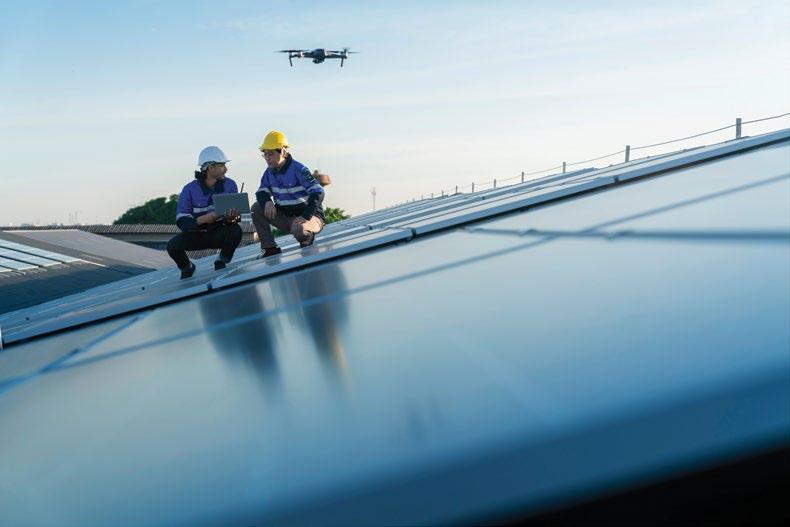
While TBH draws from our nearly six decades of project data, our eyes are firmly on the future; and digitalisation and embracing new technologies remains a key area of focus. We appreciate how far technology has aided us already, and we recognise the importance and impact it will have on the industry in future.
How do you think we will build the future?
CONSTRUCTION BUSINESS NEWS ME | AUGUST 2023 | 45 REVOLUTIONIZING CONSTRUCTION TECHNOLOGIES
IN CONSTRUCTION, WE LOVE OUR TRADITIONAL WAYS, AND WE HAVE ALL HEARD THE PHRASE “YOU CAN’T TEACH AN OLD DOG NEW TRICKS”.
ATKINS, A MEMBER OF THE SNC-LAVALIN GROUP
HOW DIGITAL TECHNOLOGY IS TRANSFORMING CONSTRUCTION
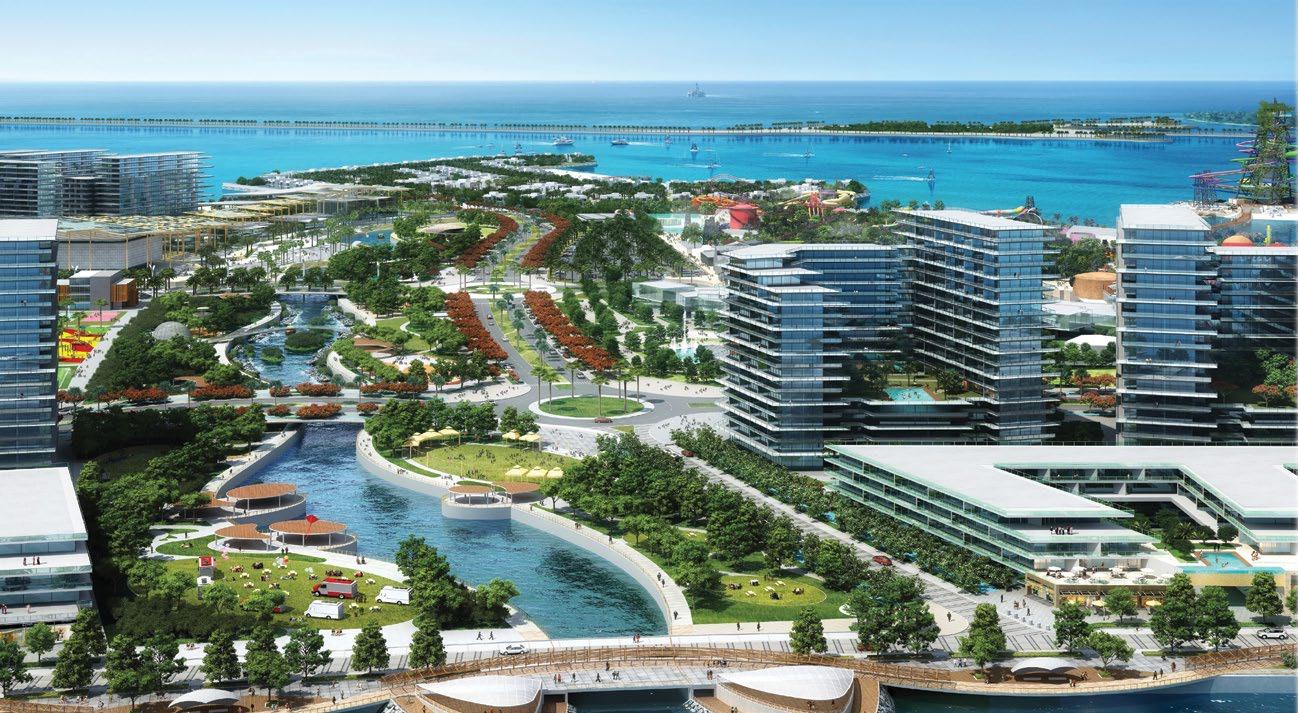
 BY ANASTASIOS DIMAS, REGIONAL DIGITAL DELIVERY LEAD, MIDDLE EAST & AFRICA & ATTILA VIDRA, DIGITAL LEAD, LAND DEVELOPMENT, MIDDLE EAST & AFRICA ATKINS, A MEMBER OF THE SNC-LAVALIN GROUP
BY ANASTASIOS DIMAS, REGIONAL DIGITAL DELIVERY LEAD, MIDDLE EAST & AFRICA & ATTILA VIDRA, DIGITAL LEAD, LAND DEVELOPMENT, MIDDLE EAST & AFRICA ATKINS, A MEMBER OF THE SNC-LAVALIN GROUP
The Middle East construction industry is seeing strong growth, particularly in Saudi Arabia and the UAE where megaprojects are increasing opportunities for innovation and collaboration. With the regional market valued at US$ 1.8 billion in 2022, and expected to grow at a significant rate of 6.3% between 2023 and 2028 , investment in construction technology has also doubled in the past decade , as the industry recognises the power of innovation to transform every element of the construction process.
While combining smart technologies and digital solutions to make operations more efficient, safe and cost-effective is a focus for the industry, the move towards more sustainable operations is also a key objective. The wider adoption of new technologies, such as Augmented Reality (AR), robots and 3D printers, is accelerating the transition towards net zero emissions, helping projects finish quicker, with less material and energy waste. With the UAE hosting COP28 later this year, the region is positioning itself as firmly committed to decarbonisation efforts and exploring net zero strategies across all operations.
Adoption of digital models to drive innovation
Data is the thread that connects traditional practices with future solutions and has the power to transform outcomes. While the construction sector has been slow in adopting digital driven solutions compared to other industries, advanced methods of data capture are becoming increasingly important to push its evolution.
Take onsite operations as an example. We are already seeing innovative uses of current technologies such as smart sensors and handheld 3D laser scanners to offer safer and more efficient data collection. Quickly capturing highquality footage, these provide data-driven insights to help influence decision-making, while minimising onsite risks. The application of machine learning to analyse this data is also evolving, enabling optimised approaches to site operations, design, health and safety, risks and much more, building greater efficiencies across projects.
Digital technologies such as robotics and drones are already playing a key role in enhancing data collection and machine learning processes. In the Middle East, robots can help conduct construction site reviews safely – especially
CBNME COVER
with harsh summer climates and megaprojects spread across remote areas. For example, Atkins used Boston Dynamic’s Spot robot to conduct routine monitoring and surveys in its nuclear operations for the US Department of Energy, driving greater efficiencies, minimising risks to humans and supporting progress towards net zero goals. This offers learnings to replicate in the built environment. In a similar way, drones are providing faster and safer data collection, cost savings and improved communication.
Countries across the Middle East are also recognising the potential of these technologies, with efforts made to update regulations and policies to support their use. Earlier this year the UAE introduced new laws to govern the design, building and use of drone near airports in Dubai, aiming to enhance the safety and security standards. As more countries follow suit and update laws that enable their wider adoption, it is expected their use will become more common in industries such as construction and this will also lead to an upskilling of the workforce to help them better understand these technologies.
Harnessing the power of data for digital design

As these technologies provide more robust data sets, the first step towards maximising the value of this is through digital design. Setting a benchmark for the region in the transition from 2D to 3D design, Atkins worked as the lead designer for Qetaifan Island North in Qatar, pioneering digital technology to create comprehensive 3D modelling. While this is now becoming common practice, the models could also be viewed in a centralised platform, utilising Virtual Reality (VR) technology to drive collaboration from stakeholders around the world.
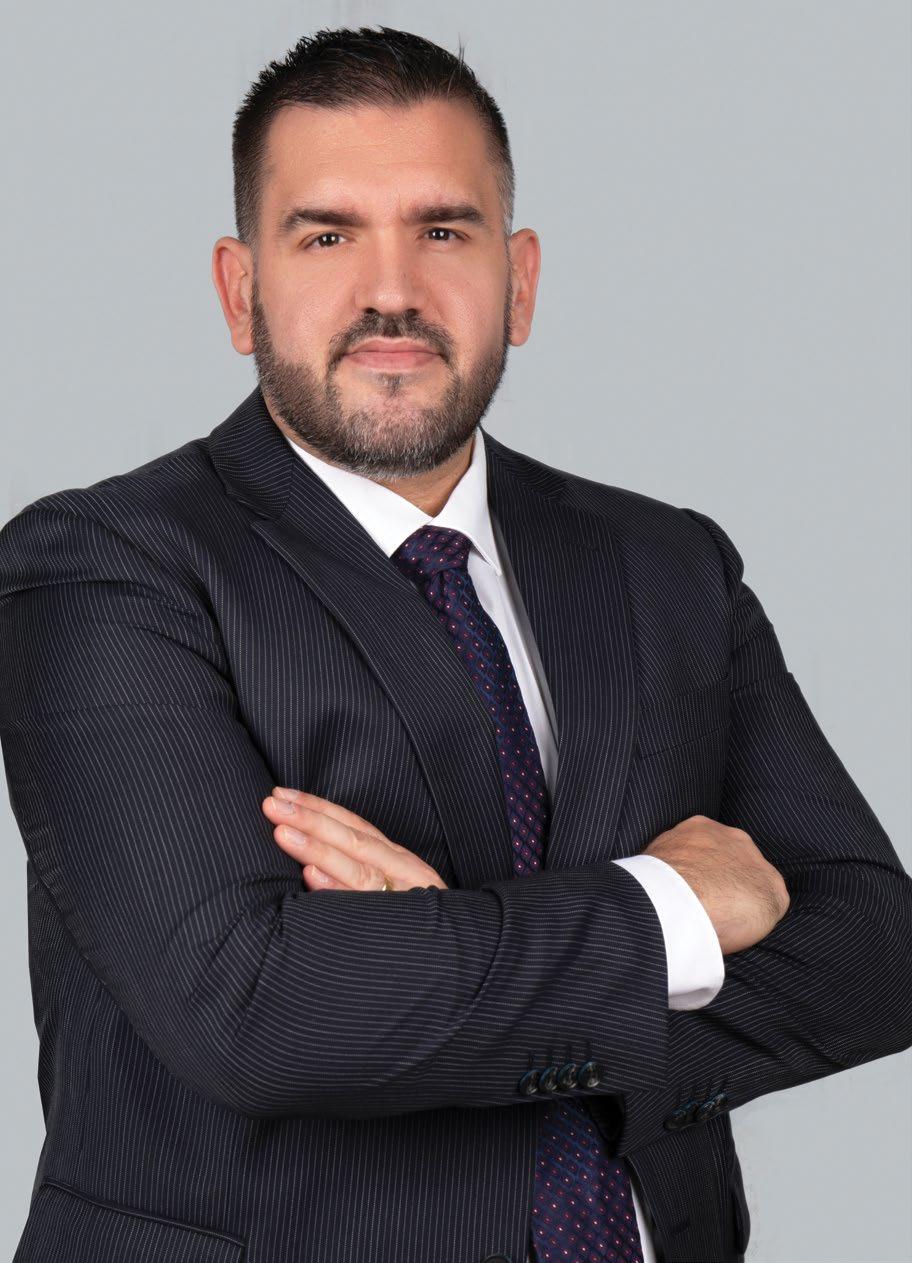
CONSTRUCTION BUSINESS NEWS ME | AUGUST 2023 | 47 REVOLUTIONIZING CONSTRUCTION TECHNOLOGIES
ATTILA VIDRA, Digital Lead, Land Development, Middle East & Africa Atkins, a member of the SNC-Lavalin Group
>>>
WHILE COMBINING SMART TECHNOLOGIES AND DIGITAL SOLUTIONS TO MAKE OPERATIONS MORE EFFICIENT, SAFE AND COST-EFFECTIVE IS A FOCUS FOR THE INDUSTRY, THE MOVE TOWARDS MORE SUSTAINABLE OPERATIONS IS ALSO A KEY OBJECTIVE.
Today, more projects are adopting these design methods, exploring extended reality to enhance complex data visualisation. In particular, VR is enabling a fully digital experience where project stakeholders can view 3D project models – and even walk through buildings – through a headset from anywhere in the world. This is particularly beneficial to drive collaboration, build workflow efficiencies and inspire greener operations, but also provides a virtual training tool in a safe learning environment. Mixed Reality (MR) and Augmented Reality (AR) are also proving to be useful onsite tools. Keeping a connection with the real world, MR enables site visitors to interact with digital and physical objects in tandem, utilising data to add holographic information to offer better interpretation of the project and review issues faster. Meanwhile, AR provides the same digital graphics through a mobile device.
Each of these have a part to play in the Middle East construction industry’s future, enhancing collaboration, productivity and helping towards net zero targets. However, the vast potential must be balanced with the need to protect
sensitive data, and this is where enhanced processes, education and industry-wide regulations come into play.
Transforming the physical world


While these technologies are reshaping the digital landscape, modular construction and 3D printing will revolutionise the physical. Examples of prefabrication and modular construction have been seen across the Middle East, mainly in some residential sites by using controlled environments for production with less waste and better quality to accelerate efficiencies and project delivery timescales. However, technological advancements will see 3D printing scale up this activity, providing benefits including reduced supply costs, decreased build times and simplified planning, along with the creation of greener process and sustainable buildings.
first 3D-printed house in Beckum, Germany, and a 3D-printed villa in Riyadh, Saudi Arabia, for example. Dubai is also home to the world’s first 3D-printed commercial building , which produced 60% less construction waste when compared to traditional methods of building. We predict it will be adopted on a much larger scale over the next decade, exploring new solutions to current challenges of high costs and scalability. The advantages are hard to ignore, and as more governments recognise its prominence – for example the Dubai Government’s ‘Dubai 3D Printing Strategy’ has pledged that 25% of new constructions will use this technology by 2030 – it’s only a matter of time before it moves from aspirational to common practice across construction.
Embracing the shift
It’s clear that technology is transforming almost every aspect of the construction process. We can see individual and small-scale implementation of tools, however, to help accelerate innovation and bring forward solutions to enable wider adoption across the Middle East’s built environment, collaboration is crucial.
that promotes investment in new solutions and training to help better connect people with new technology. By combining digital knowledge and learnings and enhancing processes and regulatory frameworks, the construction industry can unlock long-term benefits to operate more efficiently, safely and sustainably.

48 | CONSTRUCTION BUSINESS NEWS ME | AUGUST 2023 CBNME COVER
ANASTASIOS DIMAS, Regional Digital Delivery Lead, Middle East & Africa Atkins.
Your Window into the Next Generation of Property



For investors, consultants, developers and SME owners, Cityscape Global gives you unparalleled insight into the future of real estate. Discover how digital transformation, smart cities and giga-projects are shaping the Future of Living.

Foundation Par tners Destination Par tner Sponsored by Co-Organised by
Scan here to register for your free pass 10 - 13 September 2023
@csglobalksa cityscapeglobal.com
Riyadh Exhibition & Convention Center Malham - Kingdom of Saudi Arabia
RED SEA GLOBAL
PUSHING THE BOUNDARIES TO DRIVE A SUSTAINABLE FUTURE FOR CONSTRUCTION
 BY ANDREW TYSON, HEAD OF CONSTRUCTION AT RED SEA GLOBAL
BY ANDREW TYSON, HEAD OF CONSTRUCTION AT RED SEA GLOBAL

The construction industry in Saudi Arabia is one of the fastest growing in the world, currently estimated at USD 65.58 billion and expected to reach USD 75.12 billion by 2028. Driven by the guiding vision of the Kingdom to spur innovation and encourage economic growth, this strong growth has been facilitated by the rapid advancement of technology and accelerated digitalization, as well as the increased implementation of sustainable initiatives.
This drive for sustainability can also be clearly seen in the Kingdom’s construction sector, given its vital standing as an economic pillar. From renewable energy sources to prefabricated buildings, zero carbon initiatives and more, arguably the most revolutionary changes happening today are in the Saudi Arabian construction landscape.
When it comes to large-scale, sustainable and futuristic building projects, there are few contenders to the plans currently being executed throughout the Middle East, especially those in Saudi Arabia.
As the Head of Construction at Red Sea Global (RSG), I have witnessed firsthand the immense potential of synergizing cutting-edge technology with sustainability. Our commitment to environmental conservation and regenerative tourism is a beacon for all the projects falling under RSG’s umbrella. Each asset is built with sustainability in mind. In fact, throughout our giga project, we strive for full alignment with all 17 of the UN’s Sustainable Development Goals.
The construction industry has long been associated with its negative impact on the environment and local communities for the sake of progress. At RSG, we aim to break away from this norm by incorporating the best construction practices at every stage of project development while also ensuring beneficial outcomes for the environments we operate in and the neighbouring communities we serve. Our philosophy puts people and the planet first, underscoring our dedication to leaving a lasting, positive legacy for future generations and the construction industry as a whole.
50 | CONSTRUCTION BUSINESS NEWS ME | AUGUST 2023 WWW.CBNME.COM CBNME COVER
Modular construction methods as a catalyst for sustainable development


One of the key trends helping to drive the industry towards a more sustainable approach is offsite construction. While offsite construction methods are often logistically ambitious, necessitating in raising awareness among the local supply chain and stakeholders to shift from traditional construction methods, they can also provide an array of benefits from both a commercial and an environmental standpoint. It’s been noted that Modular building projects can be completed 30-50% quicker than traditional construction methods. By choosing to build modular, the indoor construction process can take place in a controlled environment in parallel with site infrastructure and foundation work.
For example, many of our Turtle Bay projects deployed an offsite manufactured, pre-finished modular solution, enabling us to complete 75% of the project construction offsite. Through embracing these innovative construction technologies and methods, we were able to simultaneously develop the required infrastructure network, onsite land raising and foundation preparation work in parallel to production work in the factory. This resulted in manufacturing time savings of 74 days in the duration of the project compared to a conventional construction approach whilst also helping us reduce waste
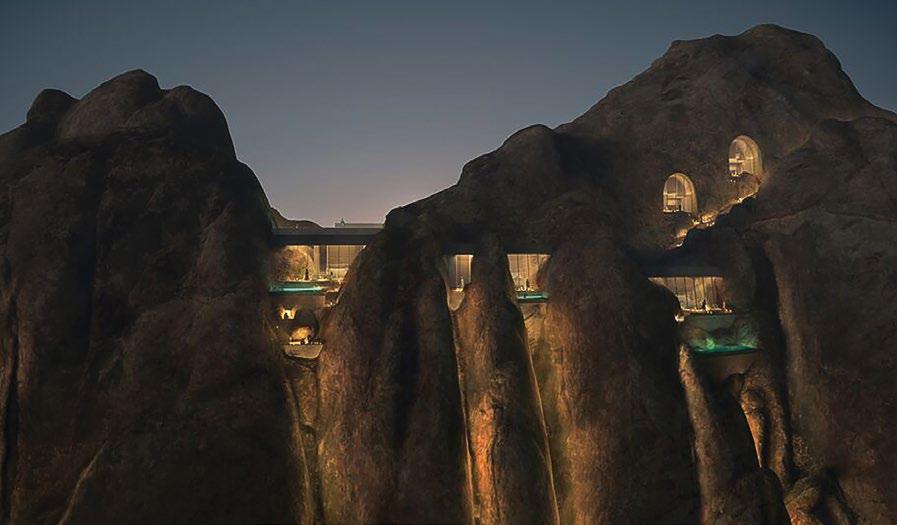
CONSTRUCTION BUSINESS NEWS ME | AUGUST 2023 | 51 REVOLUTIONIZING CONSTRUCTION TECHNOLOGIES
>>>
HILAL ASSFOUR, Principal Consultant, Turner & Townsend
WE HAVE SEEN FROM GLOBAL EXAMPLES THAT GOVERNMENTS ARE IN THE BEST POSITION TO DRIVE NATION-WIDE DIGITAL CONSTRUCTION TRANSFORMATIONS. BOTH THE UAE AND KSA GOVERNMENTS ARE ALREADY TAKING REMARKABLE STEPS TOWARDS ACHIEVING DIGITAL TRANSFORMATION ON ALL LEVELS.
and lessen the human impact of construction activities on-site, such as dust, noise, ground disturbance, and vehicle movements.
We further applied an innovative approach to modular, offsite construction with our partnership with Grankraft and Killa Design to

manufacture 73 stainless steel orbs for our Sheybarah Island resort. Fabricating the villas off-site not only meant we were able to develop the resort with minimal impact on the surrounding areas but also increased the build quality due to the controlled factory environment.
Technology led innovation

Another key area shaping the future of the industry is the integration of technology into the construction process, setting new standards throughout the design, construction and operations of our destinations. Integrating technologies such as Artificial Intelligence (AI), Internet of Things (IOT) and Building Information Modeling (BIM) is an increasingly important part of the global design and construction marketplace, enabling developers to make better, quality data-driven decisions in days rather than weeks and efficiently manage workflow, site congestion, safety, and employee tracing for health and safety considerations.
Employing smart solutions drives RSG’s sustainability compliance and enables proactive and adaptive management of the environment. For example, BIM is a core part of Red Sea Global’s pioneering “model first” environment, and the company has been working closely with project partners, building BIM capability to positively impact the Saudi market for future digitally enabled projects. We also use AI and IoT to provide an understanding of the sites’ forms, enhance forecasting models, and

52 | CONSTRUCTION BUSINESS NEWS ME | AUGUST 2023 WWW.CBNME.COM
COVER
CBNME
optimize on-site approaches as well as ensure the highest standards of worker safety through deploying smart wearable technology and wireless tagging solutions to cover our vast project area.
However, beyond these more practical uses, technology can also be harnessed to drive sustainable development. For example, at Red Sea Global we deploy IoT technology and monitoring sensors to optimally collect, track, dispose, or recycle the waste from the smart bins or compactors at reception points to an integrated waste management facility. To further minimize outgoing waste streams, the facility utilizes segregation and composting to recycle, and incineration to treat the residual parts of the incoming waste. Likewise, we use AI and machine learning tools to optimize traffic routes on site, thereby limiting traffic congestion, reducing fuel consumption, as well as reducing carbon footprint.
By leveraging the most innovative concepts and technologies, we have been able to deliver projects that accomplish huge feats of engineering whilst also protecting and enhancing the natural habitat, setting new global standards for sustainable construction and engineering.
Rewriting the industry norms
Our journey towards revolutionizing construction technologies has not been without challenges. Embracing cutting-edge techniques and technologies requires companies to break away from established industry norms as well as aligning stakeholders with our mission and vision. However, the rewards have been substantial and have successfully allowed us to preserve the natural environment whilst uplifting the local communities of the Red Sea Coast.
As we forge ahead into the future, RSG is committed to pushing the boundaries of what’s possible in construction. We will continue to pioneer regenerative tourism, lead by example, and inspire the industry to embrace and adapt to the evolving landscape in construction. By working collaboratively and leveraging innovative technologies, we can create a more sustainable and prosperous future for the Middle East and beyond. Together, we can build a world where construction is not just a means to an end, but a catalyst for positive change.



REVOLUTIONIZING CONSTRUCTION TECHNOLOGIES
WHEN IT COMES TO SUSTAINABLE AND RESILIENT INFRASTRUCTURE,
DIGITAL TWINS
ARE THE SHARPEST TOOLS IN THE SHED
BY LORI HUFFORD, VICE PRESIDENT, ENGINEERING COLLABORATION, BENTLEY SYSTEMS

54 | CONSTRUCTION BUSINESS NEWS ME | AUGUST 2023 WWW.CBNME.COM
CBNME DIGITAL TWIN
Aquick glance at any newspaper around the world will reveal stories of drought, excessive temperatures—cold and hot—water shortages, extreme flooding, storms, fires, and all sorts of climate-related catastrophes.
As communities, businesses, and governments cope with these events, we need to acknowledge that the infrastructure that we build plays a big part in addressing our relationship with our planet. Infrastructure produces economic and social advancements in
communities, but it has historically driven carbon emissions and other unwanted environmental impacts. By advancing how infrastructure is designed, built, and operated, we can aspire to meet both our economic and sustainability goals as we future-proof our physical environment from climate change.
Today, immersive technology, as a precursor to the metaverse, lets software developers create virtual, interactive worlds for any kind of purpose in any kind of setting. We can use this technology to make our infrastructure more sustainable and resilient in the real world.
Case in point, the infrastructure digital twin.

An infrastructure digital twin is a 3D digital representation of something in the physical world that is continuously updated with real-time data, making the digital twin a “live”interactive digital representation of an object or system. In interactive 3D worlds created just for entertainment, engineering-grade accuracy and the laws of physics do not have to apply. But for infrastructure, they are a requirement. Infrastructure digital twins must have millimeter precision, geospatial alignment, and support for complex, 3D engineering schemas.
Whether a water pipe buried beneath a city street or a wind turbine three miles offshore, infrastructure digital twins incorporate model data from concept through construction, such as reality data from drone surveys—including the environmental surroundings. They also gather data through devices connected to the Internet of Things (IoT), such as fixed or mobile sensors that capture detailed, engineering-rich information—including temperature fluctuations, wind speeds, and carbon emissions.
As the infrastructure engineering software company, Bentley Systems is advancing infrastructure digital twins. By pairing infrastructure digital twins with advanced visualization and simulation technology— such as Epic Games’ Unreal Engine that powers the ever-popular online interactive game, Fortnite, as well as leading platforms from NVIDIA (Omniverse) and Unity—we can leverage that data into immersive virtual experiences to analyze the harmful effects of flash flooding, monitor pollution in cities, and even manage the health of trees in an urban landscape.
Who would have thought that designing, building, and operating infrastructure in interactive digital worlds could help us track carbon emissions and conserve resources to positively impact climate change?
The key to harnessing the value for the planet related to infrastructure is a physically accurate digital twin complete with rich engineering data to model not only the built infrastructure, but also its surroundings. Imagine being able to model the real world that is affected by climate change and then generate rich metaverse experiences and simulations to find solutions. Whether it is capturing changing flood plains and ocean level rise in the natural world or analyzing the resiliency of critical infrastructure like an electrical grid, infrastructure digital twins hold the key.
A point in time view is not enough, however. By recording and modeling processes in our built and natural environments, and tracking those changes over time, we can use infrastructure digital twins like a time machine to look at where we have been, where we are now, and where we are going. This is a powerful tool to assess, change, and even reverse our carbon footprint.
CONSTRUCTION BUSINESS NEWS ME | AUGUST 2023 | 55
DIGITAL TWINS ARE THE SHARPEST TOOLS IN THE SHED
CBNME DIGITAL TWIN
Infrastructure digital twins, and the immersive interactive experiences based upon them, offer up the virtual change agents and create a stage for sustainably meeting the world’s infrastructure needs.

Technology is only of value if it is usable and accessible. Digital twin technology, with the evolving metaverse, provides accessibility across any platform to match the desired experience—web, desktop, mobile, or mixed reality. These advances reach beyond the gaming community to infrastructure designers and engineers, project managers, and other stakeholders who want to visualize and model the sustainability of their project—whether they are coordinating a construction site, touring a power plant, or redesigning a bridge to be more resilient against extreme weather. Engineers can use real-time data and artificial intelligence to take us on a simulated journey into the future and see the outcomes of design decisions, methods, and material selection that affect our carbon footprint.
Combating climate change is a global effort, and any organization trying to meet sustainable development goals needs the right tools to get there. This technology can be democratized for any project size, scope, or complexity,
regardless of where in the world the project is located. The economic and environmental benefits of using digital twins for infrastructure have no boundaries. Rather, the opensource nature of collaborating in the virtual world takes full advantage of talent from any location to solve pressing problems.
According to the Center for Strategic & International Studies, clean water infrastructure is considered “a critical aspect of the water agenda” set by the G7 Build Back Better World Partnership (B3W), and digital twin technology is poised to take on the challenges of water scarcity and sanitation on a global scale.
At the National Oceanic and Atmospheric Administration, National Climatic Data Center scientists use historical rainfall data from digital twins to virtually test the operation of existing stormwater systems. They can then forecast data to model the impact of a major storm event and see the impact that it would have on any present or future stormwater infrastructure designs. Water infrastructure projects mapped with digital twins are addressing outdated stormwater systems that are buckling under the stress of heavier rainfall and increased flooding caused by climate change.
56 | CONSTRUCTION BUSINESS NEWS ME | AUGUST 2023 WWW.CBNME.COM
Achieving a zero-emissions future could also be possible with the help of infrastructure digital twins. Scientists and engineers are working virtually using infrastructure digital twins to create a carbon-free energy experiment, with 35 countries collaborating to build the world’s largest tokamak—a magnetic fusion device intended to prove the feasibility of nuclear fusion. The International Thermonuclear Experimental Reactor (ITER) project, based in southern France, expects the experiment to generate 500 megawatts of energy to power up to 200,000 homes, if successful. The implications of this potential, unlimited source of clean energy would have an unprecedented impact on sustainable development goals.
Infrastructure digital twins continue to play an impactful role in reducing
carbon emissions from road and rail projects. The United Kingdom’s highspeed rail network is a prime example of how infrastructure digital twins enabled engineers to model the carbon impact of a rail system before the construction phase, optimizing a low-carbon design and getting on track to meet the carbon requirements set forth by the United Nation’s net-zero initiative.
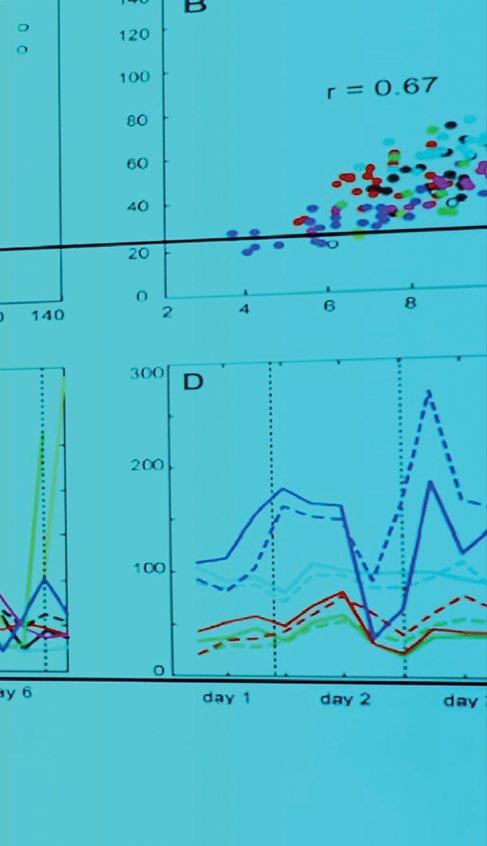
Due to the increased frequency and intensity of extreme weather events, infrastructure is under growing pressure for improved monitoring and inspection. In 2021, the New York State Department of Transportation (NYSDOT) used digital twins to assess and replace the East 138th Street bridge in New York City’s Bronx borough. Completing the project in such a congested area involved complicated structural design and coordination using a digital twin as the primary construction document. The digital twin now may be continuously updated and used as a tool for asset management and bridge inspection.
While the metaverse is evolving, some experts anticipate that it could be the next great labor platform. Right now, in the world of infrastructure, project teams and stakeholders are already meeting virtually to conduct immersive infrastructure design reviews and other critical tasks, such as on-site coordination of resources, to effectively bring those projects to completion.
Rendering of virtual worlds can be computer-intensive, driving their own carbon footprint. Being mindful of this and making efficient computing design choices should be a consideration when creating metaverse experiences.
As the needs of our world continue to grow and change in size and scope, digital twins are essential for futureproofing infrastructure and driving climate action with sustainable designs that cut carbon emissions and eliminate waste.
Infrastructure digital twins are not futuristic. As fundamental building blocks of the infrastructure metaverse, they allow groups to interact and collaborate in new ways to help solve problems today for a more sustainable and resilient tomorrow.
Lori currently leads Bentley’s Engineering Collaboration organization and is focused on advancing infrastructure design using digital twins. Prior to this role, she led Bentley’s modeling and visualization team and various digital transformation initiatives across Bentley solutions. Lori has a diverse technology background with 25 years of industry experience across both enterprise organizations and startups. Lori earned a bachelor’s degree in electrical engineering from The Ohio State University, and a master’s degree in electrical engineering and computer science from the Massachusetts Institute of Technology.

CONSTRUCTION BUSINESS NEWS ME | AUGUST 2023 | 57
DIGITAL TWINS ARE THE SHARPEST TOOLS IN THE SHED
LORI HUFFORD, VICE PRESIDENT, ENGINEERING COLLABORATION, BENTLEY SYSTEMS
LEADERSHIP
DECISION MAKING
Leadership decision making: In a race to be more technological dependent, we find out how FM C-level executives through their leadership and decision making are ensuring their companies are investing in their own technology to provide better services and how it can enhance value-added services. We have expert insights from Imdaad, Al Bonian, Adeeb Group, AG Facilities, and Emrill.

CBNME FM LEADERSHIP

LEADERSHIP DECISION MAKING
CFO | EMRILL SAM EMERY

60 | CONSTRUCTION BUSINESS NEWS ME | AUGUST 2023 WWW.CBNME.COM
FM LEADERSHIP
CBNME
Innovation in technology across the facilities management (FM) landscape is integral to increasing operational efficiencies, overall performance and customer satisfaction. FM executives are increasingly recognising the importance of investment in key technologies and the benefits digitalisation can bring to operations and clients, including enhanced service and value-added offerings, which improve customer service excellence.
Emrill began its digital transformation journey to elevate FM service delivery. Emrill has positioned itself as a market leader in developing and adopting technologically advanced tools and initiatives to provide clients with world-class services. Innovation and technology have been force multipliers in achieving Emrill’s strategic vision of delivering worldclass, total FM solutions across our 200-plus contracts, enabling us to adapt, evolve and meet the changing market landscape and unique needs of our clients. Our strong leadership focus on investing in technology has propelled Emrill’s future-proof strategies into motion to provide long-term value benefits to current and future clients. We adopt a smart, balanced, and agile approach to determining which areas of technology to invest in and utilise several methodologies to ensure we develop required technology solutions that benefit not only our clients but also the wider industry.
Emrill develops technological FM solutions based on extensive research and client feedback to implement digital solutions across diverse sectors. Through thorough assessments of our organisation and clients’ needs, we are able to identify areas of the business where technology can overcome specific challenges and provide new opportunities for service enhancements. Emrill ensures it is always at the forefront of emerging technologies adaptable to FM requirements. We focus our efforts on research and evaluation to determine a technology’s viability, enabling us to make informed decisions and prioritise
business areas that will benefit from technological advancement. Our stakeholders are continuously involved throughout our decisionmaking processes on new technology implementations. Ongoing stakeholder engagement with employees, service providers and clients ensures our investments and implementation of technologies align with their requirements and expectations. Emrill does not invest in technology just for technology’s sake; our aim is to develop solutions based on the FM industry, factoring in current and future demands, preferences and challenges. Emrill’s highly-skilled team of IT professionals leverage their expertise to create and implement our technology solutions. We strive to offer userfriendly solutions which stakeholders can easily adopt with minimal disruption to business activities. Emrill establishes key performance indicators for its service offerings to track the impact on FM service delivery and regularly evaluate the benefits to business operations and client requirements. Ongoing detailed analysis of performance metrics helps our team assess the effectiveness of implemented technologies and identify any areas for improvement if required. Implementing and adopting Emrill’s customised technologies improves service delivery and overall customer experience, including automation and increased productivity. Since the launch of our efficiency-enhancing app for vertical communities, Emrill has successfully optimised and increased manpower efficiency by 20 per cent and reduced manual supervision of tasks by 10 per cent. It has streamlined processes, improved time management, reduced errors, increased knowledge and encouraged team collaboration in embracing technology across multiple facets of businesses.
We are committed to empowering our entire workforce to carry out their roles through technology, such as Emrill Hub, our digital platform for key company services, including corporate communications and approval processes. Emrill’s latest innovative FM digital solution, Techsphere, further
enhances service excellence, client relationships and business operations while prioritising clients through an interconnected system. We have successfully created a collaborative environment where employees and customers are encouraged to share feedback and suggestions to improve FM service delivery, which Emrill then analyses and implements through innovative digitalisation approaches to further strengthen our position as an industry-leading services provider in the region.
Access to real-time data through integrated systems provides detailed data-driven insights into equipment performance, energy consumption patterns and maintenance needs, optimising operations and informed decision-making. Technology has aided our commitment to sustainability, enabling facilities to become more energy-efficient and environmentally friendly by optimising energy consumption, reducing water usage, and minimising waste generation in line with environmental objectives and the UAE’s digital and sustainability goals. Emrill’s technology solutions utilise interactive dashboards, real-time communication channels and access to information. These have led to high customer satisfaction levels and allowed us to deliver innovative and high-quality service solutions, adding value to all stakeholders and the FM industry.
Emrill believes investment in its own technologies is a way to raise FM industry standards, strengthen client relationships, and improve the effectiveness of its team and business operations. Emrill significantly invests in resources, including time and expertise, to create achievable, sustainable, and progressive digital transformation roadmaps, launching key digital FM platforms, including Techsphere, as a part of our digitalisation journey. At Emrill, we are ‘future-ready’ - continuously improving our operational processes and readily adapting to technology’s evolving nature to provide service excellence without compromising security and compliance.
CONSTRUCTION BUSINESS NEWS ME | AUGUST 2023 | 61 LEADERSHIP DECISION MAKING
TAREK NIZAMEDDIN

CEO | AG FACILITIES SOLUTIONS
In the pursuit of leading the technological transformation in Facility Management, the C-level executives are taking the lead in ensuring that their companies invest in their own technology to provide better services and enhance value-added offerings. Through their leadership and decision-making skills, these executives are driving the transformation of their organizations. Here are some ways these leaders are achieving this objective:
Strategic Vision: FM C-level executives understand the importance of a strategic vision that emphasizes technology integration. By setting a clear vision, they inspire teams to embrace technology to improve service quality and exceed customer expectations. This visionary approach guides decision-making and ensures alignment with the overall organizational objectives.
Investment Prioritization: Leaders in the FM industry recognize that investing in technology is a fundamental requirement for providing better services. They actively prioritize technology investments and allocate resources strategically to areas where they can have the greatest impact.
Embracing Innovative Technologies: FM executives actively seek out and embrace innovative technologies that can revolutionize service delivery. They stay informed about emerging trends and leverage cutting-edge solutions such as Internet of Things (IoT), Artificial Intelligence (AI), and data analytics.
Deliver exceptional customer experiences: FM leaders recognize the importance of investing in the development of mobile apps and digital tools. These innovations
provide a seamless platform for tenants and customers to interact with the FM teams, report issues, request services, and receive real-time updates. Embracing these technologies enhances communication, streamlines
issue resolution processes, and provides a level of convenience and efficiency that differentiates companies from their competitors. The goal is to create lasting partnerships with clients through superior service and
62 | CONSTRUCTION BUSINESS NEWS ME | AUGUST 2023 WWW.CBNME.COM
CBNME FM LEADERSHIP
personalized interactions. Collaboration with technology partners: By actively seeking partnerships with these partners, FM leaders can leverage their expertise and insights into emerging technologies. This collaboration enables FM companies to co-create innovative solutions that are specifically tailored to address their unique needs and challenges, through the development of customized software applications, data analytics tools, and automation
systems that meet the specific requirements of the FM industry. Driving Technological Dependence: FM C-level executives take the lead in driving technological dependence by fostering a strategic vision that emphasizes the integration of technology. They understand that technology is a crucial driver of success. Through effective leadership and decision-making, these executives create a culture of innovation and continuously seek out opportunities to invest in technology solutions that enhance service delivery, optimize operations, and drive business growth. By staying informed about emerging trends and leveraging innovative technologies, FM companies under their leadership can adapt and thrive in an ever-evolving industry. Sustainability is a vital pillar in the technological journey of FM
companies. The pressing need to reduce energy consumption and minimize environmental impact is recognized, with active contributions made to the global sustainability agenda while realizing significant cost savings. The commitment to sustainability demonstrates corporate responsibility and aligns with the values of environmentally conscious clients.

The FM industry is entering a new era where both service efficiency and sustainability have become essential priorities. Sustainability initiatives within the FM industry can be classified into six key areas: Energy, Water, Material and Resources, Workplace Management, Indoor Environment Quality, and Waste Management. FM C-level executives are committed to achieving sustainability goals by reducing greenhouse gas emissions and carbon footprint and enhancing energy efficiency, while ensuring the occupant comfort throughout their portfolios. The incorporation of cutting-edge technologies like IoT, AI, machine learning, and big data analysis has greatly contributed to improving sustainability within FM portfolios. By installing IoT sensors, optimal temperature and humidity levels can be detected to ensure the utmost satisfaction of occupants, reduce energy usage and utility bills, and drive innovation and sustainability. Through the utilization of Artificial Intelligence and Machine Learning platforms, building assets can be remotely controlled, enabling automatic shutdown features based on various factors such as occupancy, life safety, or security requirements. This automation is expected to result in significant energy savings. The objective of FM C-level executives is to deliver exceptional service quality by harnessing the latest IoT technology in conjunction with human expertise, aiming for maximum energy and staff efficiency while enhancing customer satisfaction.
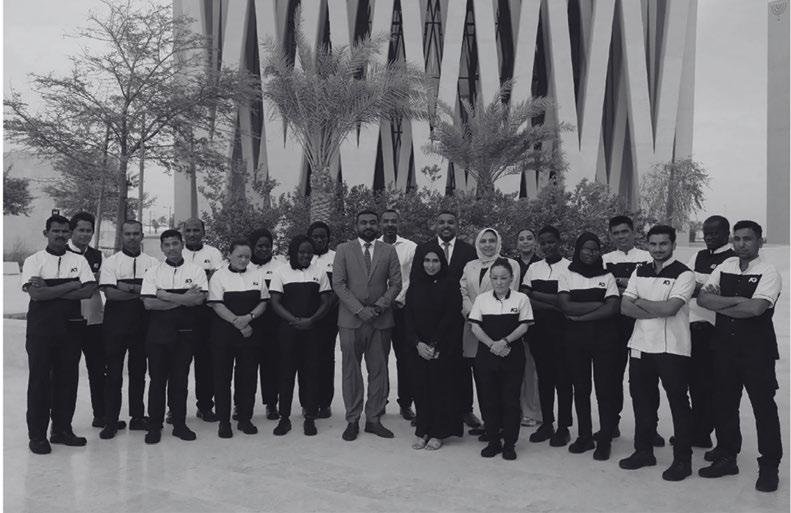
CONSTRUCTION BUSINESS NEWS ME | AUGUST 2023 | 63 LEADERSHIP DECISION MAKING
DR. ANSARI
| ADEEB GROUP
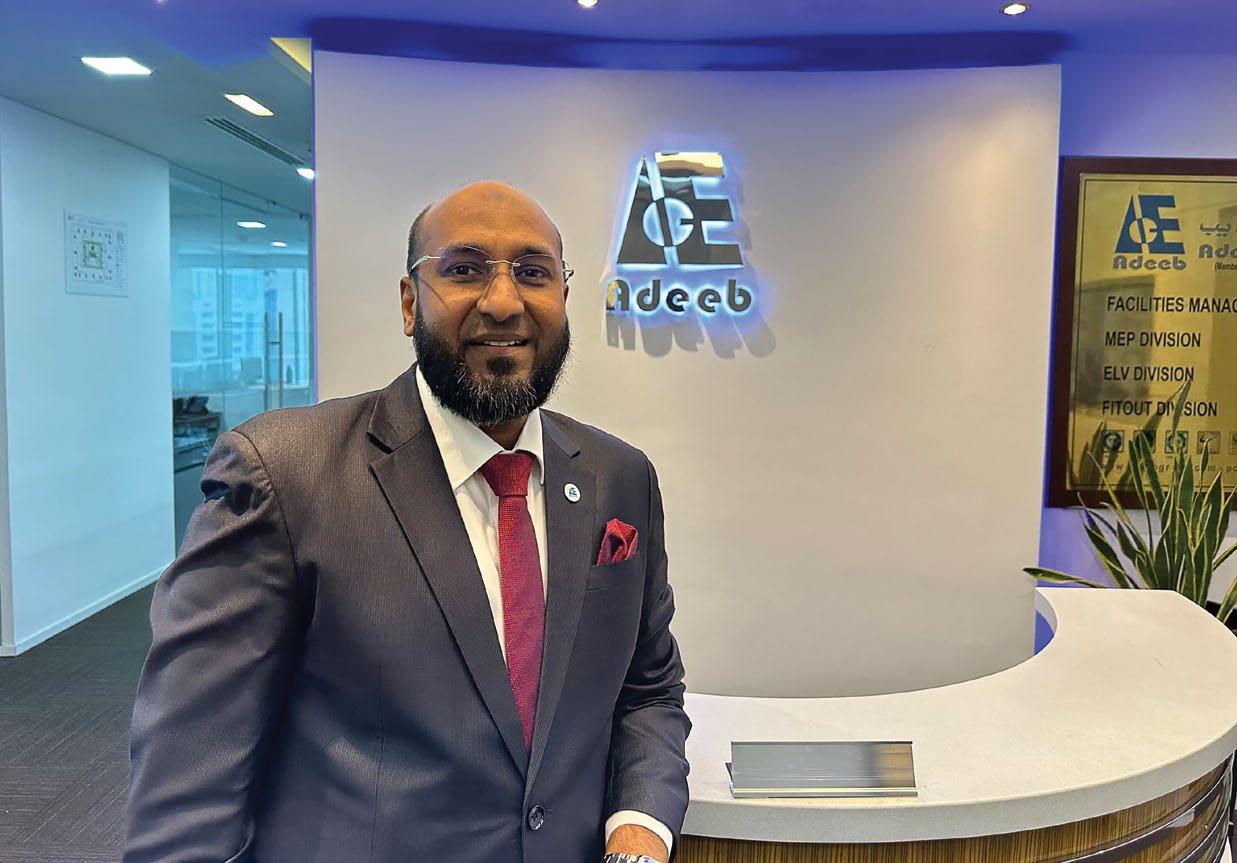
In today’s rapidly evolving industry, it can be tempting for organizations to focus on technology and digitization. While technology can be extremely instrumental in streamlining policies and processes and driving efficiency, it is important for leaders to make strategic and informed decisions pertaining to technology.
As part of the decision-making, it is important for leaders to evaluate the organization’s strategic objectives and assess whether technology will streamline effort, processes, eliminate inefficiency and risk, to enable the realization of the strategic objectives.
Leaders also need to consider the required investment (total cost of ownership) and returns, risks and opportunities, and data security.
It’s equally important, investment is made in upskilling human capital to utilize the technology effectively, and controls are designed to report on actual performance, and flexibility is built to adapt technology.
Whether technological advancements are regarded as a competitive advantage or a necessity to thrive in the industry, it’s important to weigh the potential benefits, risks, and opportunities, while considering the impact on human capital, customers, and strategic goals of the organization.
Ultimately, leadership decision-making needs to strike an optimal balance between innovation, performance, cost, and risk, to ensure that technology will deliver long term value to the organization, and its customers and shareholders.
64 | CONSTRUCTION BUSINESS NEWS ME | AUGUST 2023 WWW.CBNME.COM
CBNME FM LEADERSHIP
CEO

TONY MARTIN
Before we get to the technology part, lets discuss what is Leadership decision making, and how is it different from any others decision making? Is it because a leader of an organisation makes decisions that may have an impact on a business, therefore an impact on the employees, or in this case a decision on investment in technology, that has an impact not only on the efficiency but also the environment as a whole?
Just to clarify, you don’t need to be a CEO or C Level Executive to be a leader. Leaders are at all levels of the
workplace; anyone can follow and implement what I am writing below. Go for it!
Leadership decision-making is a critical aspect of effective leadership, encompassing the process of making choices and taking actions that guide an organization towards its goals. Let’s look at some of the key principles and considerations for effective leadership decision-making:
1. Clarity of Purpose: Leaders must have a clear understanding of the organization’s mission, vision, and strategic goals.
2. Gathering Information: Effective decision-making requires gathering
relevant and reliable information. Leaders should seek input from various sources, such as subject matter experts, data analysis, market research, and stakeholder perspectives.

3. Analytical Thinking: Leaders should employ analytical thinking to assess the available information and evaluate potential options. This involves critically analysing data, considering potential outcomes and risks, and weighing the pros and cons of different alternatives.
4. Stakeholder Engagement: Engaging stakeholders is crucial to decisionmaking, as it helps gather diverse perspectives and insights. By actively seeking input, leaders can gain valuable insights, build consensus, and increase the likelihood of successful implementation.
5. Ethical Considerations: Ethical decision-making is an essential aspect of effective leadership. Leaders must consider the ethical implications and consequences of their choices.
6. Risk Assessment: Leaders should evaluate the potential risks and rewards associated with each decision. This involves considering financial, operational, reputational, and strategic risks, and developing contingency plans when necessary.
7. Collaboration and Empowerment: Effective leaders foster a collaborative and inclusive decision-making environment. They encourage teamwork, open communication, and diverse perspectives, empowering team members to contribute their ideas and expertise. By involving others in the decision-making process, leaders can tap into the collective intelligence of the team and increase buy-in and commitment to the chosen course of action.
8. Decisiveness and Accountability: Leaders should demonstrate decisiveness when making decisions, avoiding unnecessary delays or indecisiveness. Once a decision is made, leaders must take ownership and be accountable for the outcomes. This involves monitoring progress, evaluating results, and making adjustments as needed.
9. Learning from Mistakes: Effective
66 | CONSTRUCTION BUSINESS NEWS ME | AUGUST 2023 WWW.CBNME.COM CBNME FM LEADERSHIP
MBA FIWFM, CEO | AL BONIAN
leaders understand that not all decisions will lead to the desired outcomes. When mistakes happen, they take responsibility, learn from them, and make necessary adjustments.
10. Flexibility and Adaptability: Leadership decision-making should be adaptable to changing circumstances. The principles above, if followed and implemented, would pretty much cover what would be required in any decision-making process. Sometimes this process can take 30secs, or 30 mins, or even 30 days. It depends on many factors, there is no exact science, we are all individuals. We work and think in different ways. Though you won’t go far wrong with these 10 principles. You may only even have to use one of them in the decision-making process. Personally, I am a big believer in collaboration and empowerment, and then having the decisiveness to make a decision, with a clarity of purpose that aligns with the company’s vision.
In the race to become more technologically dependent, FM Leaders play a crucial role in driving their companies’ investment in technology and leveraging it to provide better services and enhance value-added offerings. Let’s look at some of the key-aspects that need to be considered.
1. Vision and Strategy: FM Leaders need to develop a clear vision for how technology can transform their company’s operations and services. They must articulate a strategic plan that outlines how technology investments align with the organization’s goals and values. This vision should encompass the potential for technology to enhance value-added services, improve efficiency, and drive innovation.
2. Needs Assessment: FM Leaders should conduct a comprehensive assessment of their company’s technological needs and identify areas where investment can have the greatest impact. This involves understanding customer demands, analysing industry trends, and evaluating internal processes to identify opportunities for technological advancements.
3. Collaboration and Cross-Functional Alignment: Technology investments should not be made in isolation. Leaders should foster collaboration and alignment among different departments, including IT, operations, marketing, and customer service. This ensures that technology decisions are well-integrated and address the needs of various stakeholders.

4. Risk Management: Technology investments carry inherent risks, including financial, operational, and security considerations. FM Leaders should employ effective risk management strategies to mitigate these risks. This involves conducting thorough due diligence, assessing the financial viability of investments, and implementing robust cybersecurity measures.
5. Agile Decision-Making: Technology evolves rapidly, and FM Leaders need to adapt their decision-making processes accordingly. Embracing agile methodologies allows for iterative decision-making, rapid prototyping, and frequent evaluation of technological solutions. This approach enables companies to stay ahead of the curve and respond quickly to changing market dynamics.
6. Measuring Performance and Value Creation: FM Leaders should establish
key performance indicators (KPIs) and metrics to assess the effectiveness and impact of technology investments. This includes evaluating the return on investment (ROI), customer satisfaction levels, operational efficiency gains, and the ability to deliver value-added services. By effectively leading and making strategic decisions in technology investment, FM Leaders can leverage advancements to enhance services, improve operational efficiency, and create new value propositions. Their leadership plays a critical role in positioning their companies as technological leaders in the industry, providing a competitive advantage and driving long-term success.
Just as we do here at Al Bonian FM. Expect the Best!
CONSTRUCTION BUSINESS NEWS ME | AUGUST 2023 | 67 LEADERSHIP DECISION MAKING
“PERSONALLY, I AM A BIG BELIEVER IN COLLABORATION AND EMPOWERMENT, AND THEN HAVING THE DECISIVENESS TO MAKE A DECISION, WITH A CLARITY OF PURPOSE THAT ALIGNS WITH THE COMPANY’S VISION.."
IMDAAD
REDEFINING THE FM SECTOR THROUGH TECHNOLOGY AND INNOVATIONS
In the journey spanning 16 years since its inception in 2007, the leadership at Imdaad has maintained a proactive approach towards adapting cutting-edge technology solutions to become a regional leader in providing sustainable and innovative facility management services.
The advent of new technologies and prudent adaptation of apt and fitting solutions have become game changers to businesses. As with any other sector, technology has profoundly impacted and influenced the operation of facility management (FM) companies.
The adoption and successful integration of tech solutions have strengthened business units to eliminate human errors, automate processes, digitize data storage, manage human capital, and reduce operating costs. The advanced solutions have also enabled entities to comply with regulations and safeguard assets as well as workforces.
In this scenario, it is inevitable for business leaders to make discerning decisions while investing in technology. Imdaad, the Middle East’s leading integrated facility management company, has been at the forefront of adapting advanced technology solutions.
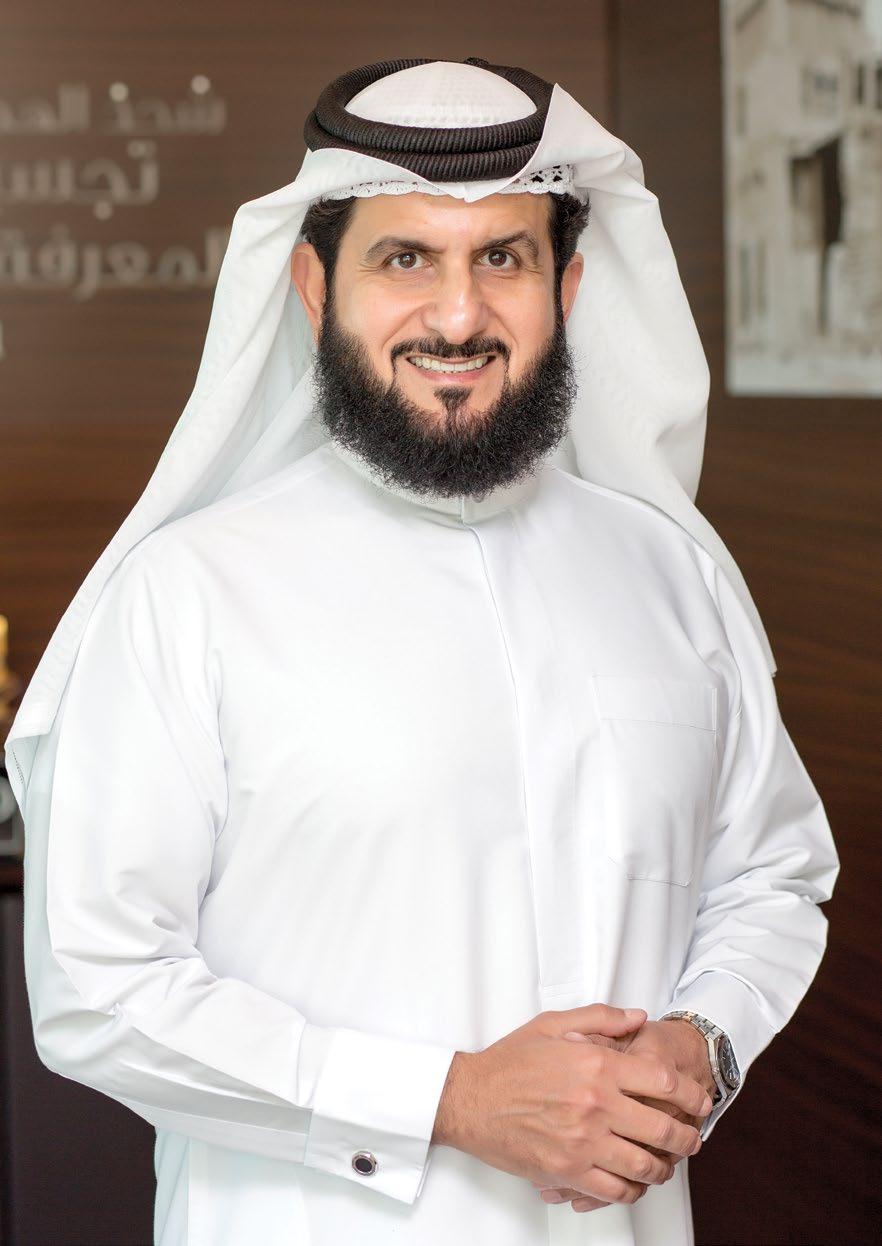
In the journey spanning 16 years since its inception in 2007, the leadership at Imdaad has maintained a proactive approach towards innovative technology solutions, making them the pioneers of digital transformation in the sector.
The successful integration of artificial intelligence (AI), machine learning, Internet of Things (IoT), among other technologies, has bolstered the position Imdaad of as a regional leader in providing sustainable and innovative facility management solutions to its clients and partners.
Imdaad was one of the first facility management companies in the region to pioneer data-driven solutions. One of the groundbreaking IoT-based innovations at the company was the development of Ignite Shield’s Smart Water Analyser Device - an innovative water quality monitoring solution. The
68 | CONSTRUCTION BUSINESS NEWS ME | AUGUST 2023 WWW.CBNME.COM CBNME FM LEADERSHIP
device enabled real-time monitoring of water quality in swimming pools and tanks.
Earlier, a person had to collect water samples to gather data on temperature, pH value, and free chlorine rates. The Smart Water Analyzer device replaced this laborious process and offered an error-free, easy, and convenient digital solution. The innovation was a game changer in the UAE and regional FM sector.
Another major technology-driven innovation at Imdaad was the implementation of SAHAL, a tailormade, end-to-end paperless work order management system. While automating and digitizing a paperbased, human-dependent process, SAHAL also contributed to the sustainability goals by reducing paper usage.
The introduction of the EFFY app and Enterprise Resource Planning (ERP) tool at Imdaad demonstrated how tech-enabled solutions can simplify and enhance human productivity while working with complex data sets. The digital solutions empowered Imdaad to accurately and in real-time track operational data and efficiently allocate resources across its massive operating facilities.
Further, the evolution of AI, robotics, and other technologies has empowered facility management companies to predict preventive maintenance requirements, capture accurate data to reduce operational costs, enhance productivity, and eliminate observational errors.
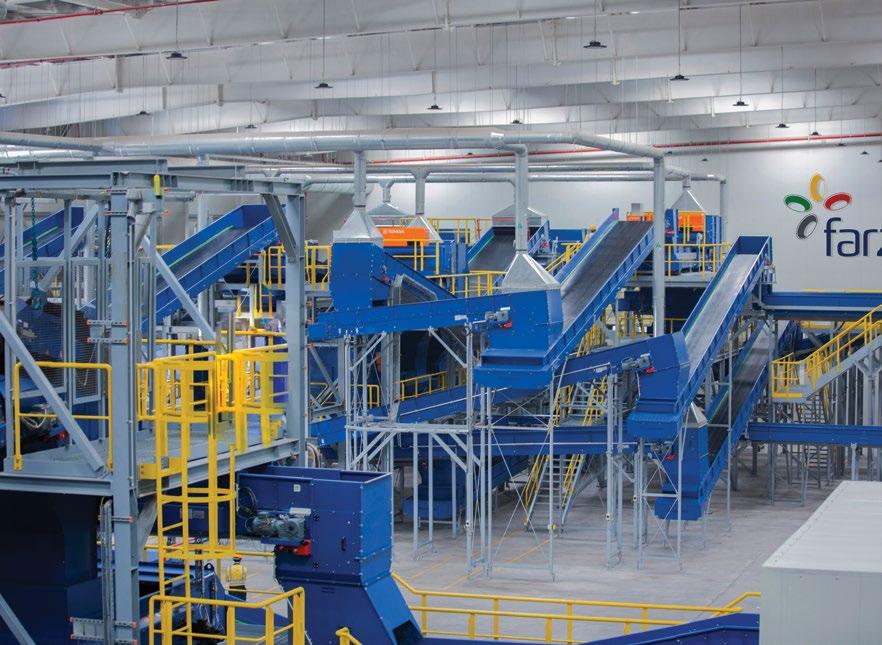
Commitment to Sustainability
The adoption of sustainable practices is pivotal to Imdaad and is committed to support the UAE in championing its fight against climate action. Protection of the environment by cutting down on carbon footprints is a business priority for the FM leader.
Imdaad is the only facility management company in the region to operate a fleet of waste management vehicles running on biofuel. It also possesses an electric fleet of recycling pick-up vehicles. The FM leader also
procures eco-friendly biocides and cleaning materials.
The company further strengthened its commitment to sustainability by exploring and investing in initiatives to enhance the UAE’s Recycling and Sustainability sector.
By using advanced building management systems, intelligent lighting solutions, and energy monitoring tools, Imdaad maximizes energy efficiency while minimizing waste. Furthermore, cutting-edge AI-powered technologies substantially reduce energy consumption. These sustainable practices empower the company to reduce its environmental footprint by delivering cost-saving solutions to its clients as an additional benefit.
Founded and stewarded under the able leadership of Jamal Abdulla Lootah, who adorns the position of Group CEO at Imdaad, the company has grown to become much more than a facility management company in the region offering a wide range of services from the management of hard and soft FM to environmental solutions, materials recovery facility, energy
management, residential maintenance, fire safety, automation and waste collection.
Imdaad’s growth and success attests to its visionary leadership, abled workforce, and meticulous investment in empowering technology solutions. Integration of technology has enabled Imdaad to automate its massive operations and engage efficiently with clients through proper allocation of resources.
Imdaad has now become a recognisable force in the FM sector in the UAE, handling the FM requirements for major corporations and government clients. However, Imdaad’s aspirations are not limited to the UAE but to expand its business operations across the Arab world and beyond. Recently, the group entered the Egyptian FM market by striking a deal with a major operator in the country. With the Facility Management sector poised to grow, Imdaad aims to be the frontrunner in the sector setting new benchmarks through innovation and making a meaningful difference in the world we all live and work in.
CONSTRUCTION BUSINESS NEWS ME | AUGUST 2023 | 69 LEADERSHIP DECISION MAKING
3DXB: 3D PRINTERS DESIGNED FOR LARGE-SCALE CONSTRUCTION PROJECTS

Badar Rashid AlBlooshi, Chairman of 3DXB GROUP, speaks to Kasun Illankoon on how 3DXB has been formulated in alignment with the UAE’s visionary decree, which aims to construct 25 percent of buildings using 3D printing technology by 2030.
How does 3DXB’s mission align with the UAE’s goal of constructing 25 percent of buildings using 3D printing technology by 2030?
In alignment with the UAE’s visionary decree No. (24) of 2021 issued by His Highness Sheikh Mohammed bin Rashid Al Maktoum to regulate the use of 3D printing in the construction sector in Dubai, which supports the Emirate’s strategic target to ensure that 25% of its buildings are constructed using 3D printing technology by 2030, 3DXB GROUP has been formulated in the UAE as the only regional company to offer a complete 3D building solutions for the construction sector.
The company arrives during the UAE’s push for innovation and technological advancement in various sectors, including construction. The UAE aims to construct 25% of buildings using 3D printing technology by 2030, highlighting their commitment to cutting-edge solutions and pushing beyond traditional methods. This objective aligns with key benefits of 3D printing technology: faster and more efficient construction, cost savings, design flexibility, and sustainability. 3DXB specializes in 3D printing for construction, sharing the UAE’s vision for widespread adoption of this technology to foster innovation and create a sustainable and efficient construction industry.
70 | CONSTRUCTION BUSINESS NEWS ME | AUGUST 2023 WWW.CBNME.COM CBNME 3D PRINTING
What specific components does 3DXB offer as part of their complete solution for 3D printing technology in construction?
3D PRINTING EQUIPMENT: 3DXB provides specialized 3D printers designed for large-scale construction projects, featuring robotic arms or gantry systems for precise material deposition.
CONSTRUCTION MATERIALS: 3DXB develops and supplies specialized materials suitable for 3D printing in construction, including cementitious mixtures, additives, polymers, and composites that meet structural integrity and printability requirements.
SOFTWARE AND DESIGN TOOLS: 3DXB offers sophisticated software and design tools to generate digital models and convert them into printable files, either through proprietary solutions or collaborations with existing software providers.
SUPPORT AND TRAINING: 3DXB, in partnership with Dubai Municipality
and universities, offers comprehensive technical support, training, and consultancy services to assist construction firms in adopting and implementing 3D printing technology. This includes machine setup, troubleshooting, maintenance, and guidance on best practices.
RESEARCH AND DEVELOPMENT: 3DXB collaborates with universities and government entities to invest in research and development, aiming to enhance their technologies and advance the capabilities of 3D printing in the construction industry.
How does 3DXB plan to transfer essential skills to architects, engineers, and developers to maximize the potential of 3D printing in building construction?
1 . SUPPORT AND TRAINING: 3DXB with Dubai Municipality and universities in this sector offer comprehensive technical support, training, and consultancy services to assist
construction firms in adopting and implementing 3D printing technology
2. PROJECT MANAGEMENT AND IMPLEMENTATION: 3DXB offer project management services, overseeing the entire process of integrating 3D printing technology into construction projects. This can involve project planning, feasibility assessments, coordination with stakeholders, and on-site implementation of 3D printing processes.
What are some of the limitations of current 3D printing technology in building construction, and how does 3DXB aim to overcome them?
SCALE AND SIZE CONSTRAINTS: Limited build volumes of current 3D printers used in construction may restrict the size of printed structures, requiring multiple stages or assembly of smaller components for large-scale projects. MATERIAL LIMITATIONS: The range of construction materials for 3D printing is somewhat limited compared to traditional methods, although concrete and certain polymers are commonly used.
STRUCTURAL INTEGRITY AND QUALITY CONTROL: Ensuring the strength and durability of 3D-printed buildings is crucial, with challenges such as layer adhesion, material homogeneity, and uniformity affecting structural integrity. DESIGN COMPLEXITY: Printing intricate architectural features or designs with overhangs may pose challenges, often requiring support structures or additional post-processing steps.
REGULATORY AND STANDARDIZATION CHALLENGES: Building codes and regulations may not fully address the specific requirements of 3D-printed structures, and standardization efforts are still evolving.
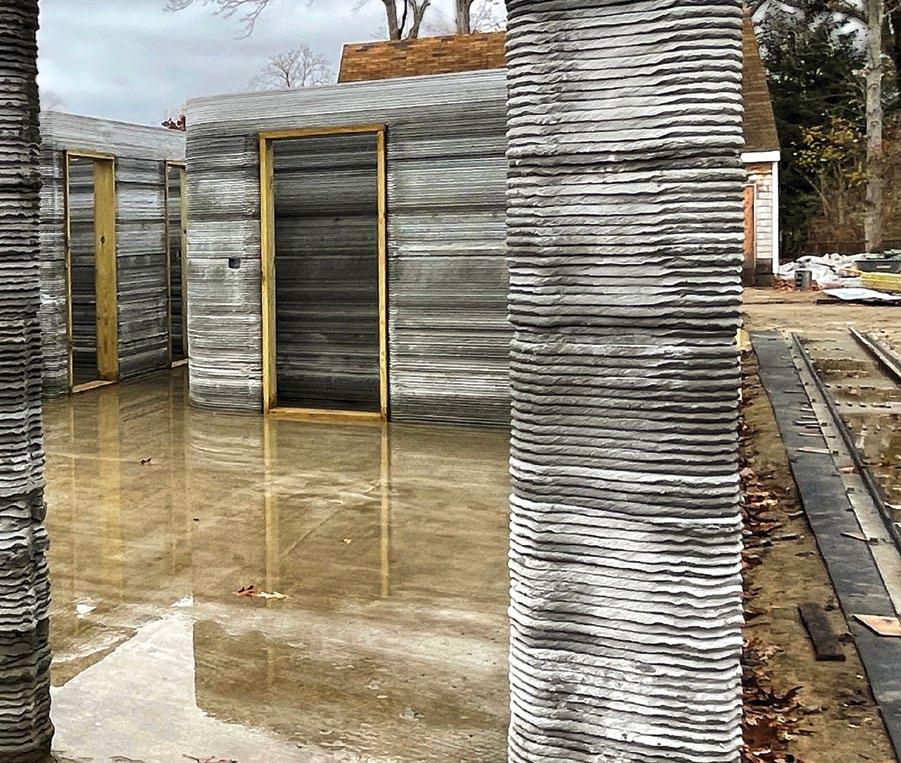
To overcome these limitations, 3DXB: Invests in research and development, aiming to improve scalability, optimize materials, and enhance printing techniques.
Collaborates with Dubai Municipality to develop 3D printing technology locally, including mixes, printers, training, and dissemination at regional and global levels. >>>
CONSTRUCTION BUSINESS NEWS ME | AUGUST 2023 | 71
3DXB | 3D PRINTERS DESIGNED FOR LARGE-SCALE CONSTRUCTION PROJECTS
CBNME 3D PRINTING
Explores new construction materials tailored for 3D printing, focusing on advanced concrete mixtures, polymers, and composites with improved strength, durability, and printability.
Optimizes the printing process by refining parameters, enhancing layer adhesion, and implementing real-time monitoring systems for consistent and reliable outcomes.
Collaborates with industry stakeholders, regulatory bodies, and standardization organizations to establish guidelines and standards for 3D printing in construction, addressing regulatory challenges and ensuring compliance. Provides education and training
programs to enhance professionals’ understanding of design considerations and best practices for 3D printing in construction, helping them optimize their approach.
What distinguishes 3DXB’s approach to 3D printing in building construction from existing methods, especially in terms of surpassing the G+2 limit?
To surpass existing limits in building height and complexity, 3DXB in the 3D printing technology for construction sector employs specific strategies: ADVANCED PRINTING TECHNIQUES: 3DXB develops or uses advanced printing techniques, such as Maxi Printer robotic arms, to construct taller and

larger-scale structures.
STRUCTURAL REINFORCEMENT: Implementation of reinforcement strategies, such as steel reinforcements or post-tensioning systems, enhances the strength and stability of 3D-printed structures, surpassing height limitations.

MATERIAL ENHANCEMENTS:
Improvements in construction materials, like stronger concrete mixtures or highperformance polymers, contribute to surpassing height limits by offering enhanced load-bearing capacities and structural properties.
DESIGN OPTIMIZATION: By optimizing the design and geometry of 3D-printed structures using computational tools and engineering expertise, companies maximize the strength-to-weight ratio and ensure efficient material usage and structural performance.
REGULATORY COLLABORATION:
Companies collaborate closely with regulatory authorities and building code organizations to address the challenges and limitations of 3D printing in construction. This collaboration helps shape regulations that enable the construction of taller 3D-printed
72 | CONSTRUCTION BUSINESS NEWS ME | AUGUST 2023 WWW.CBNME.COM
buildings while ensuring safety and compliance.
It’s important to consider that surpassing specific height limitations with 3D printing technology depends on factors such as local building regulations, technological advancements, and the expertise of companies like 3DXB.
Could you provide more details about the advanced technologies and state-ofthe-art 3D printing techniques that 3DXB plans to leverage in their construction projects?
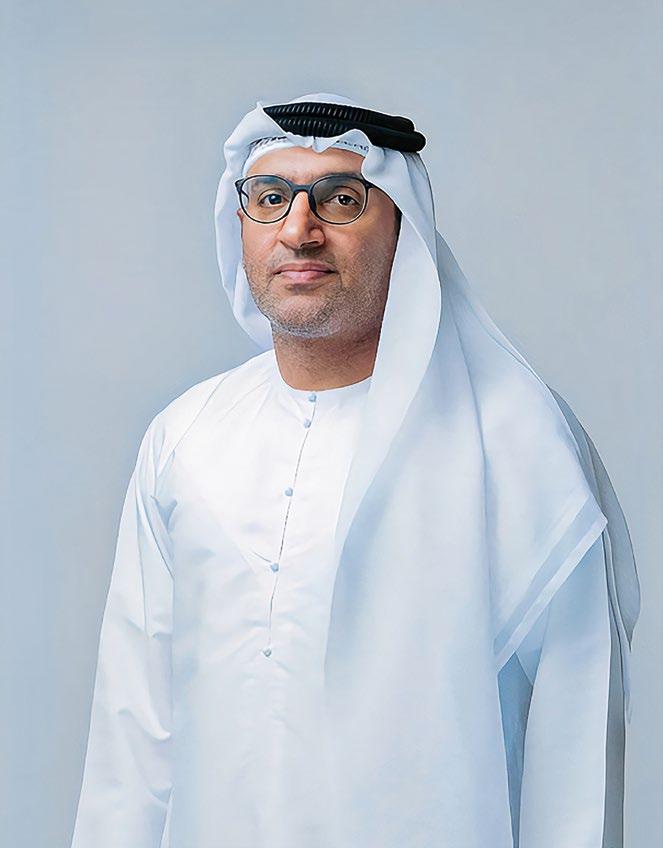

Robotic Arm: Advanced 3D printing systems for construction use robotic arms to precisely deposit materials, enabling the printing of largescale structures.
CONTINUOUS PRINTING: This technique allows for seamless and uninterrupted printing of structures, improving efficiency and enabling longer spans or
continuous walls.
MULTI-MATERIAL PRINTING: Advanced systems handle multiple materials simultaneously, enabling the incorporation of different materials within a single structure for enhanced performance and aesthetics.
AUTOMATED REINFORCEMENT PLACEMENT: Automation places reinforcement elements during the printing process, enhancing structural integrity and load-bearing capacity.
IN SITU PRINTING: Structures are printed directly at the construction site, improving efficiency and enabling printing in hard-to-access areas.
ADAPTIVE CONTROL SYSTEMS: Real-time monitoring and adjustment of printing parameters optimize the process, ensuring quality control and accounting for material and environmental variations.
CONSTRUCTION BUSINESS NEWS ME | AUGUST 2023 | 73
3DXB | 3D PRINTERS DESIGNED FOR LARGE-SCALE CONSTRUCTION PROJECTS
ENSURING THE STRENGTH AND DURABILITY OF 3D-PRINTED BUILDINGS IS CRUCIAL, WITH CHALLENGES SUCH AS LAYER ADHESION, MATERIAL HOMOGENEITY, AND UNIFORMITY AFFECTING STRUCTURAL INTEGRITY.
BADAR RASHID ALBLOOSHI, Chairman of 3DXB GROUP
CBNME
and leadership, LEED certification provides a valuable framework for healthy, efficient, carbon and cost-saving green buildings. LEED Zero is the latest and highest category under the LEED certification program and represents a new level of achievement in the region.
The distinctive sculptural form of the 32-story Mashreq Global Headquarters designed by Skidmore, Owings & Merrill LLP (SOM), builds on the sustainable self-shading strategy pioneered in the Middle East by the Chicago-based architectural firm. The high-performance glass facades are orientated for reduced solar transmission and its MEP systems are optimized through an automated Building Management System. Incorporating the highest standards of sustainability, both in design excellence and operations, and achieving 36% reduction in overall energy consumption against industry baseline, the stone-clad L-shaped tower was certified as LEED for Operations and Maintenance (O+M) in 2022.
As a LEED Zero Energy building, the Mashreq Global Headquarters operates at optimum efficiency on site and its energy consumption is also being offset through renewables. Mashreq’s current offset commitment of three years will be continued beyond 2026.

LEED Zero EnergY
JLL’S ENERGY AND SUSTAINABILITY SERVICES ENABLE LEED ZERO CERTIFICATION FOR MASHREQ GLOBAL HEADQUARTERS
In line with its vision to lead the real estate industry into a healthier and more environmentally sustainable future, JLL, a leading professional services firm specialized in real estate and investment management, has collaborated with Mashreq, one of the leading financial institutions in the UAE and the Middle East, to realize the net zero ambitions of the bank’s global headquarters.
Leveraging JLL’s energy and sustainability services, the 38,484 sqm Mashreq Global Headquarters in Downtown Dubai is the first commercial tower in MENA and the 2nd building in the Middle East to achieve the LEED Zero Energy (Leadership in Energy and Environmental Design) certification by the US Green Building Council in recognition of its efforts in addressing netzero resources (energy, water, and waste) and net-zero carbon operations.
Mashreq’s commitment to driving efficiencies in resource management and improving indoor environmental quality across the built environment earned it the LEED Gold certification last year. A globally recognized symbol of sustainability achievement
Louise Collins, Head of Project & Development Services UAE & Head of Engineering & Energy MEA at JLL, said: “Through a holistic approach that combines expertise and technology the building has proven that Zero Energy operations is possible in the region. The LEED Zero recognition is a testament to Mashreq’s strong commitment towards making tangible progress with real greenhouse gas reductions and builds on its vision to streamline operations through impactful climate resilient strategies to achieve low energy and reduced carbon footprints.”
“JLL are continuing to work with Mashreq on driving energy intensity reductions and position it for long-term successes across its full property asset portfolio. We hope that more organizations and building owners in the region will take bold actions and follow Mashreq’s lead in pursuing a multi-phased sustainable journey and optimize their pathways in the transition to net zero,” she added.
Bassem Fekry Farid, Executive Vice President, Head of Corporate Real Estate & Administration, Mashreq, said: “We are proud to achieve the prestigious LEED Zero Energy certification for our Global Headquarters, making it the first commercial tower in the UAE and the 2nd building in the Middle East to accomplish this remarkable feat. This accomplishment reflects our unwavering commitment to environmental sustainability and our efforts towards a greener future and a greener economy. Our partnership with JLL’s energy and sustainability services has been instrumental in realizing our net zero ambitions. We believe that through bold actions and impactful strategies, we can inspire other organizations and building owners in the region to join us on this sustainable journey towards a low-energy, reduced carbon footprint future. With the upcoming COP 28 event scheduled to be held in the UAE later this year, achieving this certification further solidifies Mashreq’s position as a sustainability champion and a leading force in shaping, contributing to, and supporting the MENA region’s strategic path towards achieving Net Zero.”
74 | CONSTRUCTION BUSINESS NEWS ME | AUGUST 2023 WWW.CBNME.COM
REPORT
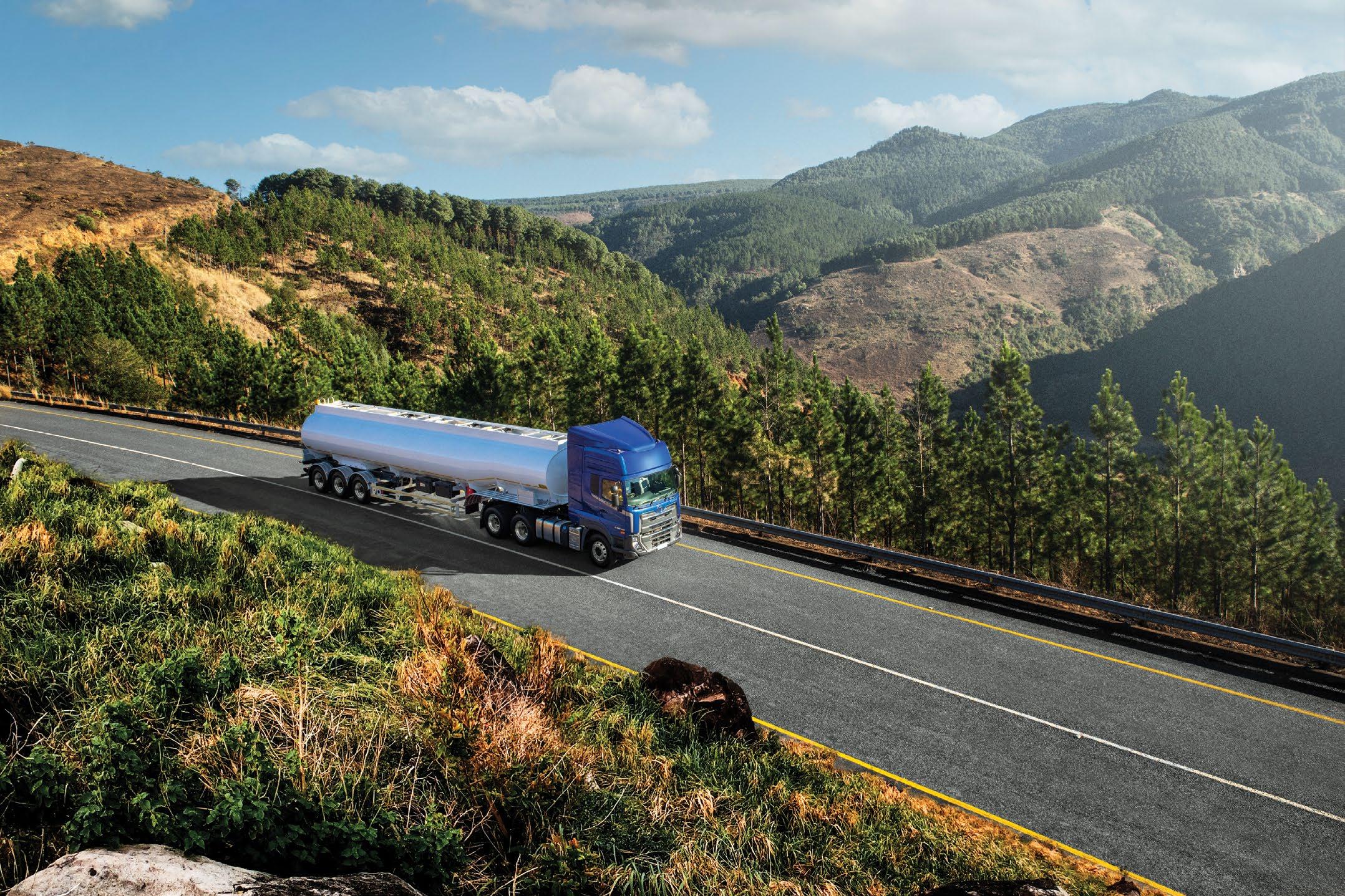




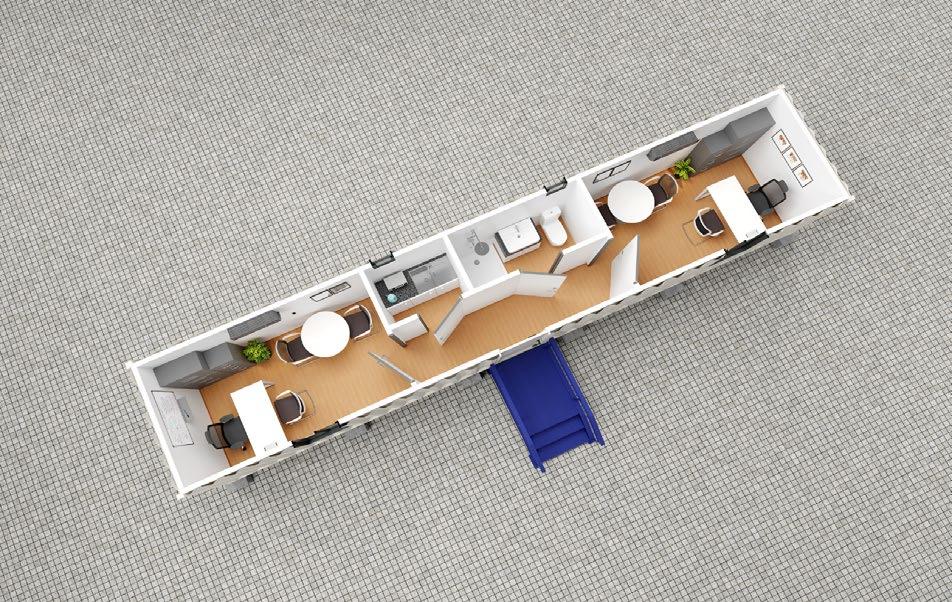
 THE DEFINITIVE GUIDE TO THE REGION'S CONSTRUCTION PROFESSIONALS
THE DEFINITIVE GUIDE TO THE REGION'S CONSTRUCTION PROFESSIONALS









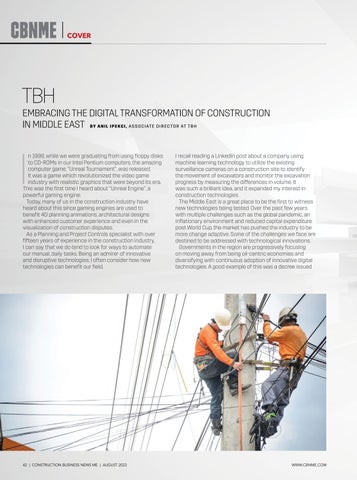

























 BY KASUN ILLANKOON
BY KASUN ILLANKOON







 BY GILES PENDLETON, EXECUTIVE DIRECTOR OF THE LINE
BY GILES PENDLETON, EXECUTIVE DIRECTOR OF THE LINE



 BY HILAL ASSFOUR, PRINCIPAL CONSULTANT, TURNER & TOWNSEND
BY HILAL ASSFOUR, PRINCIPAL CONSULTANT, TURNER & TOWNSEND
























 BY ASMAA ABOULEISH, BIM MANAGER, EGIS SAUDI ARABIA
BY ASMAA ABOULEISH, BIM MANAGER, EGIS SAUDI ARABIA

 BY ANIL IPEKCI, ASSOCIATE DIRECTOR AT TBH
BY ANIL IPEKCI, ASSOCIATE DIRECTOR AT TBH















































